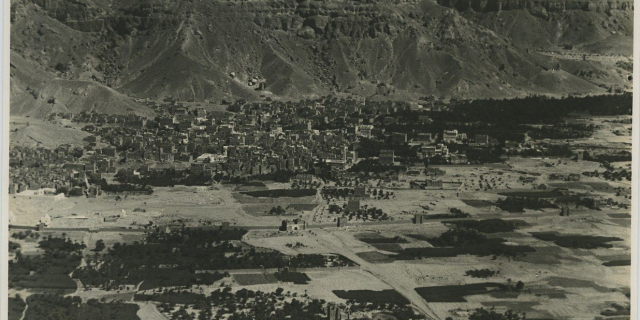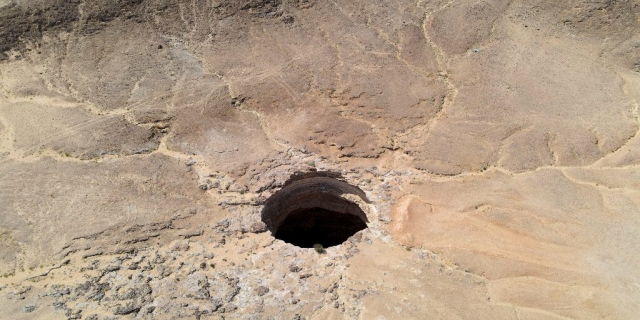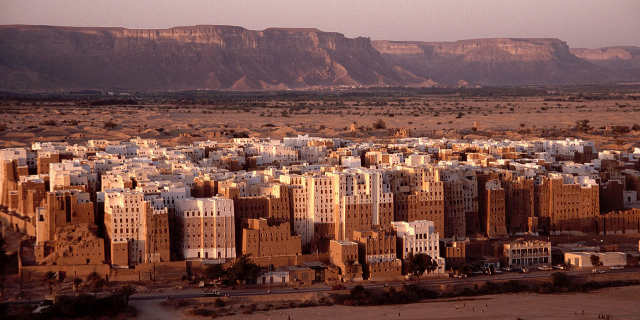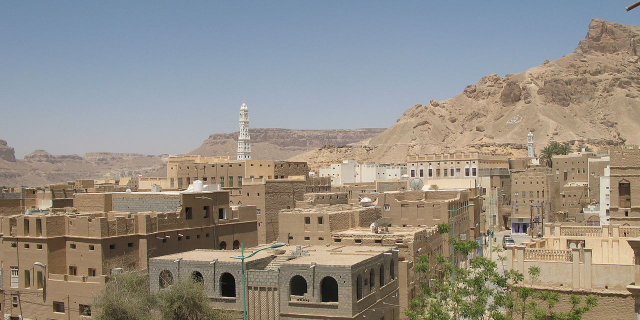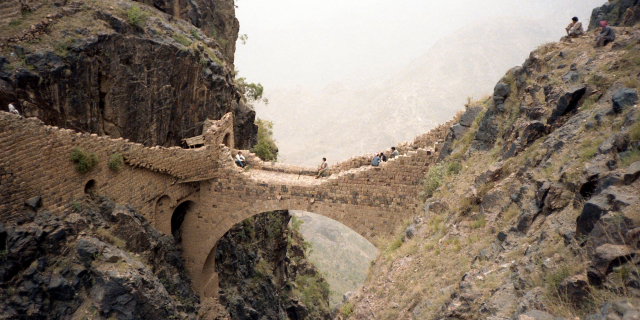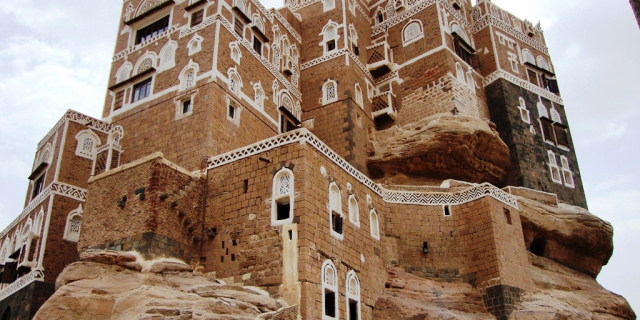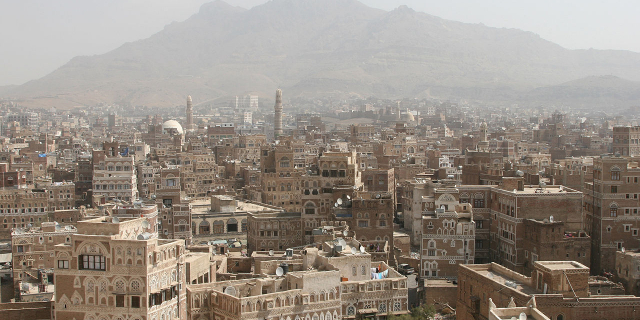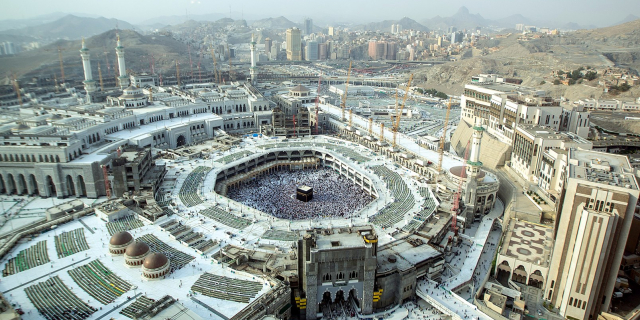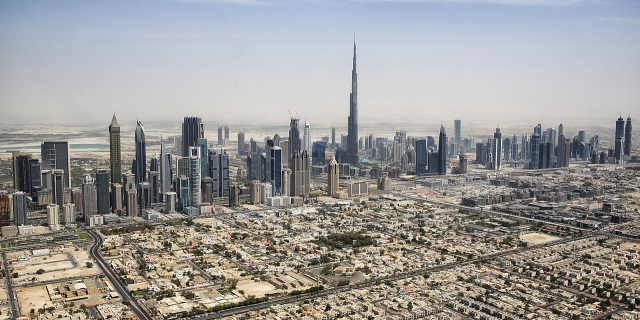اليمن
YemenContext of Yemen
Yemen ( (listen); Arabic: ٱلْيَمَن, romanized: al-Yaman), officially the Republic of Yemen, is a country in Western Asia with a tiny portion in East Africa. It is situated on the southern end of the Arabian Peninsula, and borders Saudi Arabia to the north and Oman to the northeast and shares maritime borders with Eritrea, Djibouti, Somaliland and Somalia. Yemen is the second-largest Arab sovereign state in the Arabian Peninsula, occupying 555,000 square kilometres (214,000 square miles), with a coastline stretching about 2,000 kilometres (1,200 miles). Its constitutionally stated capital, and largest city, is Sanaa. As of 2021, Yemen has an estimated population of 30.4 million.
In ancient times, Yemen was the home of the Sabaeans, a trading state that...Read more
Yemen ( (listen); Arabic: ٱلْيَمَن, romanized: al-Yaman), officially the Republic of Yemen, is a country in Western Asia with a tiny portion in East Africa. It is situated on the southern end of the Arabian Peninsula, and borders Saudi Arabia to the north and Oman to the northeast and shares maritime borders with Eritrea, Djibouti, Somaliland and Somalia. Yemen is the second-largest Arab sovereign state in the Arabian Peninsula, occupying 555,000 square kilometres (214,000 square miles), with a coastline stretching about 2,000 kilometres (1,200 miles). Its constitutionally stated capital, and largest city, is Sanaa. As of 2021, Yemen has an estimated population of 30.4 million.
In ancient times, Yemen was the home of the Sabaeans, a trading state that included parts of modern-day Ethiopia and Eritrea. Later in 275 AD, the Himyarite Kingdom was influenced by Judaism. Christianity arrived in the fourth century. Islam spread quickly in the seventh century and Yemenite troops were crucial in the early Islamic conquests. Several dynasties emerged in the 9th to 16th centuries, such as the Rasulid dynasty. The country was divided between the Ottoman and British empires in the 1800s. The Zaydi Mutawakkilite Kingdom of Yemen was established after World War I before the creation of the Yemen Arab Republic in 1962. South Yemen remained a British protectorate as the Aden Protectorate until 1967 when it became an independent state and later, a Marxist-Leninist state. The two Yemeni states united to form the modern Republic of Yemen (al-Jumhūrīyah al-Yamanīyah) in 1990. President Ali Abdullah Saleh was the first president of the new republic until his resignation in 2012 in the wake of the Arab Spring.
Since 2011, Yemen has been in a state of political crisis starting with street protests against poverty, unemployment, corruption, and president Saleh's plan to amend Yemen's constitution and eliminate the presidential term limit. President Saleh stepped down and the powers of the presidency were transferred to Abdrabbuh Mansur Hadi. Since then, the country has been in a civil war (alongside the Saudi Arabian-led military intervention aimed at restoring Hadi's government against Iran-backed Houthi rebels) with several proto-state entities claiming to govern Yemen: the government of President Hadi which became the Presidential Leadership Council in 2022, the Houthi movement's Supreme Political Council, and the separatist Southern Movement's Southern Transitional Council. At least 56,000 civilians and combatants have been killed in armed violence in Yemen since January 2016. The war has resulted in a famine affecting 17 million people. The lack of safe drinking water, caused by depleted aquifers and the destruction of the country's water infrastructure, has also caused the largest, fastest-spreading cholera outbreak in modern history, with the number of suspected cases exceeding 994,751. Over 2,226 people have died since the outbreak began to spread rapidly at the end of April 2017. The ongoing humanitarian crisis and conflict has received widespread criticism for having a dramatic worsening effect on Yemen's humanitarian situation, that some say has reached the level of a "humanitarian disaster" and some have even labelled it as a genocide. It has worsened the country's already-poor human rights situation.
Yemen is a member of the Arab League, the United Nations, the Non-Aligned Movement and the Organisation of Islamic Cooperation. It belongs to the least developed country group, referring to its numerous "severe structural impediments to sustainable development", and has been the poorest country in the MENA region in recent history. In 2019, the United Nations reported that Yemen is the country with the most people in need of humanitarian aid, about 24 million people, or 85% of its population. As of 2020, the country is placed the highest in the Fragile State Index, the second worst in the Global Hunger Index, surpassed only by the Central African Republic, and has the lowest Human Development Index out of all non-African countries.
More about Yemen
- Currency Yemeni rial
- Native name اليمن
- Calling code +967
- Internet domain .ye
- Mains voltage 230V/50Hz
- Democracy index 1.95
- Population 28250420
- Area 555000
- Driving side right
Yemen has existed at the crossroads of civilisations for more than 3,000 years. The country was home to figures such as the Queen of Sheba who brought a caravan of gifts for King Solomon. For centuries, it became a primary producer of coffee exported in the port of Mocha. The Ancient Romans called this area Arabia Felix or Happy Arabia. From its conversion to Islam in the 7th century, Yemen became a center of Islamic learning and much of its architecture survived until modern times.
...Read moreRead lessYemen has existed at the crossroads of civilisations for more than 3,000 years. The country was home to figures such as the Queen of Sheba who brought a caravan of gifts for King Solomon. For centuries, it became a primary producer of coffee exported in the port of Mocha. The Ancient Romans called this area Arabia Felix or Happy Arabia. From its conversion to Islam in the 7th century, Yemen became a center of Islamic learning and much of its architecture survived until modern times.
Ancient history Ruins of the Great Dam of Marib
Ruins of the Great Dam of MaribWith its long sea border between eastern and western civilizations, Yemen has long existed at a crossroads of cultures with a strategic location in terms of trade on the west of the Arabian Peninsula. Large settlements for their era existed in the mountains of northern Yemen as early as 5000 BC.[1]
The Sabaean Kingdom came into existence in at least the 12th century BC.[2] The four major kingdoms or tribal confederations in South Arabia were Saba, Hadramout, Qataban, and Ma'in. Sabaʾ (Arabic: سَـبَـأ)[3][4] is thought to be biblical Sheba and was the most prominent federation.[5] The Sabaean rulers adopted the title Mukarrib generally thought to mean unifier,[6] or a priest-king,[7] or the head of the confederation of South Arabian kingdoms, the "king of the kings".[8] The role of the Mukarrib was to bring the various tribes under the kingdom and preside over them all.[9] The Sabaeans built the Great Dam of Marib around 940 BC.[10] The dam was built to withstand the seasonal flash floods surging down the valley.
Between 700 and 680 BC, the Kingdom of Awsan dominated Aden and its surroundings and challenged the Sabaean supremacy in the Arabian South. Sabaean Mukarrib Karib'il Watar I conquered the entire realm of Awsan,[11] and expanded Sabaean rule and territory to include much of South Arabia.[12] Lack of water in the Arabian Peninsula prevented the Sabaeans from unifying the entire peninsula. Instead, they established various colonies to control trade routes.[13]
 A funerary stela featuring a musical scene, 1st century AD
A funerary stela featuring a musical scene, 1st century ADEvidence of Sabaean influence is found in northern Ethiopia, where the South Arabian alphabet, religion and pantheon, and the South Arabian style of art and architecture were introduced.[14][15][16] The Sabaean created a sense of identity through their religion. They worshipped El-Maqah and believed that they were his children.[17] For centuries, the Sabaeans controlled outbound trade across the Bab-el-Mandeb, a strait separating the Arabian Peninsula from the Horn of Africa and the Red Sea from the Indian Ocean.[18]
By the third century BC, Qataban, Hadramout, and Ma'in became independent from Saba and established themselves in the Yemeni arena. Minaean rule stretched as far as Dedan,[19] with their capital at Baraqish. The Sabaeans regained their control over Ma'in after the collapse of Qataban in 50 BC. By the time of the Roman expedition to Arabia Felix in 25 BC, the Sabaeans were once again the dominating power in Southern Arabia.[20] Aelius Gallus was ordered to lead a military campaign to establish Roman dominance over the Sabaeans.[21]
The Romans had a vague and contradictory geographical knowledge about Arabia Felix or Yemen. The Roman army of 10,000 men was defeated before Marib.[22] Strabo's close relationship with Aelius Gallus led him to attempt to justify his friend's defeat in his writings. It took the Romans six months to reach Marib and 60 days to return to Egypt. The Romans blamed their Nabataean guide and executed him for treachery.[23] No direct mention in Sabaean inscriptions of the Roman expedition has yet been found.
After the Roman expedition – perhaps earlier – the country fell into chaos, and two clans, namely Hamdan and Himyar, claimed kingship, assuming the title King of Sheba and Dhu Raydan.[24] Dhu Raydan, i.e., Himyarites, allied themselves with Aksum in Ethiopia against the Sabaeans.[25] The chief of Bakil and king of Saba and Dhu Raydan, El Sharih Yahdhib, launched successful campaigns against the Himyarites and Habashat, i.e., Aksum, El Sharih took pride in his campaigns and added the title Yahdhib to his name, which means "suppressor"; he used to kill his enemies by cutting them to pieces.[26] Sana'a came into prominence during his reign, as he built the Ghumdan Palace as his place of residence.
 Himyarite King Dhamar'ali Yahbur II
Himyarite King Dhamar'ali Yahbur II A Sabaean gravestone of a woman holding a stylized sheaf of wheat, a symbol of fertility in ancient Yemen
A Sabaean gravestone of a woman holding a stylized sheaf of wheat, a symbol of fertility in ancient YemenThe Himyarite annexed Sana'a from Hamdan around 100 AD.[27] Hashdi tribesmen rebelled against them and regained Sana'a around 180 AD.[28] Shammar Yahri'sh had not conquered Hadramout, Najran, and Tihama until 275 AD, thus unifying Yemen and consolidating Himyarite rule.[29][30] The Himyarites rejected polytheism and adhered to a consensual form of monotheism called Rahmanism.[31]
In 354 AD, Roman Emperor Constantius II sent an embassy headed by Theophilos the Indian to convert the Himyarites to Christianity.[32] According to Philostorgius, the mission was resisted by local Jews.[33] Several inscriptions have been found in Hebrew and Sabaean praising the ruling house in Jewish terms for "...helping and empowering the People of Israel."[34]
According to Islamic traditions, King As'ad the Perfect mounted a military expedition to support the Jews of Yathrib.[35] Abu Kariba As'ad, as known from the inscriptions, led a military campaign to central Arabia or Najd to support the vassal Kingdom of Kinda against the Lakhmids.[36] However, no direct reference to Judaism or Yathrib was discovered from his lengthy reign. Abu Kariba died in 445 AD, having reigned for almost 50 years.[37] By 515 AD, Himyar became increasingly divided along religious lines and a bitter conflict between different factions paved the way for an Aksumite intervention. The last Himyarite king Ma'adikarib Ya'fur was supported by Aksum against his Jewish rivals. Ma'adikarib was Christian and launched a campaign against the Lakhmids in southern Iraq, with the support of other Arab allies of Byzantium.[38] The Lakhmids were a Bulwark of Persia, which was intolerant to a proselytizing religion like Christianity.[39]
After the death of Ma'adikarib Ya'fur around 521 AD, a Himyarite Jewish warlord named Yousef Asar Yathar rose to power with the honorary title of Yathar (meaning, "to avenge"). Yemenite Christians, aided by Aksum and Byzantium, systematically persecuted Jews and burned down several synagogues across the land. Yousef avenged his people with great cruelty.[40] He marched toward the port city of Mocha, killing 14,000 and capturing 11,000.[38] Then he settled a camp in Bab-el-Mandeb to prevent aid flowing from Aksum. At the same time, Yousef sent an army under the command of another Jewish warlord, Sharahil Yaqbul, to Najran. Sharahil had reinforcements from the Bedouins of the Kinda and Madh'hij tribes, eventually wiping out the Christian community in Najran.[41]
Yousef or Dhu Nuwas (the one with sidelocks) as known in Arabic literature, believed that Christians in Yemen were a fifth column.[42] Christian sources portray Dhu Nuwas (Yousef Asar) as a Jewish zealot, while Islamic traditions say that he threw 20,000 Christians into pits filled with flaming oil.[40][33] Dhu Nuwas left two inscriptions, neither of them making any reference to fiery pits. Byzantium had to act or lose all credibility as a protector of eastern Christianity. It is reported that Byzantium Emperor Justin I sent a letter to the Aksumite King Kaleb, pressuring him to "...attack the abominable Hebrew."[38] A tripartite military alliance of Byzantine, Aksumite, and Arab Christians successfully defeated Yousef around 525–527 AD and a client Christian king was installed on the Himyarite throne.[43]
Esimiphaios was a local Christian lord, mentioned in an inscription celebrating the burning of an ancient Sabaean palace in Marib to build a church on its ruins.[44] Three new churches were built in Najran alone.[44] Many tribes did not recognize Esimiphaios's authority. Esimiphaios was displaced in 531 by a warrior named Abraha, who refused to leave Yemen and declared himself an independent king of Himyar.[45]
Emperor Justinian I sent an embassy to Yemen. He wanted the officially Christian Himyarites to use their influence on the tribes in inner Arabia to launch military operations against Persia. Justinian I bestowed the "dignity of king" upon the Arab sheikhs of Kindah and Ghassan in central and northern Arabia.[45] From early on, Roman and Byzantine policy was to develop close links with the powers of the coast of the Red Sea. They were successful in converting[clarification needed] Aksum and influencing their culture. The results concerning to Yemen were rather disappointing.[45]
A Kendite prince called Yazid bin Kabshat rebelled against Abraha and his Arab Christian allies. A truce was reached once the Great Dam of Marib had suffered a breach.[46] Abraha died around 570 AD; Sources regarding his death are available from the Qur'an and Hadith. The Sasanid Empire annexed Aden around 570 AD. Under their rule, most of Yemen enjoyed great autonomy except for Aden and Sana'a. This era marked the collapse of ancient South Arabian civilization since the greater part of the country was under several independent clans until the arrival of Islam in 630 AD.[47]
Middle Ages Advent of Islam and the three dynasties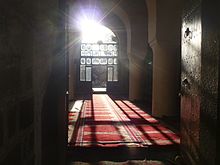 The interior of the Great Mosque of Sana'a, the oldest mosque in Yemen
The interior of the Great Mosque of Sana'a, the oldest mosque in YemenMuhammad sent his cousin Ali to Sana'a and its surroundings around 630 AD. At the time, Yemen was the most advanced region in Arabia.[48] The Banu Hamdan confederation was among the first to accept Islam. Muhammad sent Muadh ibn Jabal, as well to Al-Janad, in present-day Taiz, and dispatched letters to various tribal leaders. The reason behind this was the division among the tribes and the absence of a strong central authority in Yemen during the days of the prophet.[49]
Major tribes, including Himyar, sent delegations to Medina during the "year of delegations" around 630–631 AD. Several Yemenis accepted Islam before the year 630, such as Ammar ibn Yasir, Al-Ala'a Al-Hadrami, Miqdad ibn Aswad, Abu Musa Ashaari, and Sharhabeel ibn Hasana. A man named 'Abhala ibn Ka'ab Al-Ansi expelled the remaining Persians and claimed he was a prophet of Rahman. He was assassinated by a Yemeni of Persian origin called Fayruz al-Daylami. Christians, who were mainly staying in Najran along with Jews, agreed to pay jizyah (Arabic: جِـزْيَـة), although some Jews converted to Islam, such as Wahb ibn Munabbih and Ka'ab al-Ahbar.
Yemen was stable during the Rashidun Caliphate. Yemeni tribes played a pivotal role in the Islamic expansion of Egypt, Iraq, Persia, the Levant, Anatolia, North Africa, Sicily, and Andalusia.[50][51][52] Yemeni tribes who settled in Syria, contributed significantly to the solidification of Umayyad rule, especially during the reign of Marwan I. Powerful Yemenite tribes such as Kinda were on his side during the Battle of Marj Rahit.[53][54]
Several emirates led by people of Yemeni descent were established in North Africa and Andalusia. Effective control over entire Yemen was not achieved by the Umayyad Caliphate. Imam Abdullah ibn Yahya Al-Kindi was elected in 745 AD to lead the Ibāḍī movement in Hadramawt and Oman. He expelled the Umayyad governor from Sana'a and captured Mecca and Medina in 746.[55] Al-Kindi, known by his nickname "Talib al-Haqq" (seeker of truth), established the first Ibadi state in the history of Islam but was killed in Taif around 749.[55]
Muhammad ibn Abdullah ibn Ziyad founded the Ziyadid dynasty in Tihama around 818 AD. The state stretched from Haly (in present-day Saudi Arabia) to Aden. They nominally recognized the Abbasid Caliphate but were ruling independently from their capital in Zabid.[56] The history of this dynasty is obscure. They never exercised control over the highlands and Hadramawt, and did not control more than a coastal strip of Yemen (Tihama) bordering the Red Sea.[57] A Himyarite clan called the Yufirids established their rule over the highlands from Saada to Taiz, while Hadramawt was an Ibadi stronghold and rejected all allegiance to the Abbasids in Baghdad.[56] By virtue of its location, the Ziyadid dynasty of Zabid developed a special relationship with Abyssinia. The chief of the Dahlak islands exported slaves, as well as amber and leopard hides, to the then ruler of Yemen.[58]
The first Zaidi imam, Yahya ibn al-Husayn, arrived in Yemen in 893 AD. He was the founder of the Zaidi imamate in 897. He was a religious cleric and judge who was invited to come to Saada from Medina to arbitrate tribal disputes.[59] Imam Yahya persuaded local tribesmen to follow his teachings. The sect slowly spread across the highlands, as the tribes of Hashid and Bakil, later known as "the twin wings of the imamate", accepted his authority.[60]
Yahya established his influence in Saada and Najran. He also tried to capture Sana'a from the Yufirids in 901 AD but failed miserably. In 904, the Isma'ilis under Ibn Hawshab and Ali ibn al-Fadl al-Jayshani invaded Sana'a. The Yufirid emir As'ad ibn Ibrahim retreated to Al-Jawf, and between 904 and 913, Sana'a was conquered no less than 20 times by Isma'ilis and Yufirids.[61] As'ad ibn Ibrahim regained Sana'a in 915. Yemen was in turmoil as Sana'a became a battlefield for the three dynasties, as well as independent tribes.
The Yufirid emir Abdullah ibn Qahtan attacked and burned Zabid in 989, severely weakening the Ziyadid dynasty.[62] The Ziyadid monarchs lost effective power after 989, or even earlier than that. Meanwhile, a succession of slaves held power in Zabid and continued to govern in the name of their masters, eventually establishing their own dynasty around 1022 or 1050 according to different sources.[63] Although they were recognized by the Abbasid Caliphate in Baghdad, they ruled no more than Zabid and four districts to its north.[64] The rise of the Isma'ili Sulayhid dynasty in the Yemeni highlands reduced their history to a series of intrigues.
Sulayhid dynasty (1047–1138)Jibla became the capital of the dynasty. Featured is the Queen Arwa Mosque. Queen Arwa al-Sulaihi Palace
Queen Arwa al-Sulaihi PalaceThe Sulayhid dynasty was founded in the northern highlands around 1040; at the time, Yemen was ruled by different local dynasties. In 1060, Ali ibn Muhammad Al-Sulayhi conquered Zabid and killed its ruler Al-Najah, founder of the Najahid dynasty. His sons were forced to flee to Dahlak.[65] Hadramawt fell into Sulayhid hands after their capture of Aden in 1162.[66]
By 1063, Ali had subjugated Greater Yemen.[67] He then marched toward Hejaz and occupied Makkah.[68] Ali was married to Asma bint Shihab, who governed Yemen with her husband.[69] The Khutba during Friday prayers was proclaimed in both her husband's name and hers. No other Arab woman had this honor since the advent of Islam.[69]
Ali al-Sulayhi was killed by Najah's sons on his way to Mecca in 1084. His son Ahmed Al-Mukarram led an army to Zabid and killed 8,000 of its inhabitants.[70] He later installed the Zurayids to govern Aden. al-Mukarram, who had been afflicted with facial paralysis resulting from war injuries, retired in 1087 and handed over power to his wife Arwa al-Sulayhi.[71] Queen Arwa moved the seat of the Sulayhid dynasty from Sana'a to Jibla, a small town in central Yemen near Ibb. Jibla was strategically near the Sulayhid dynasty source of wealth, the agricultural central highlands. It was also within easy reach of the southern portion of the country, especially Aden. She sent Ismaili missionaries to India, where a significant Ismaili community was formed that exists to this day.[72] Queen Arwa continued to rule securely until her death in 1138.[72]
Arwa al-Sulayhi is still remembered as a great and much-loved sovereign, as attested in Yemeni historiography, literature, and popular lore, where she is referred to as Balqis al-sughra ("the junior queen of Sheba").[73] Although the Sulayhids were Ismaili, they never tried to impose their beliefs on the public.[74] Shortly after Queen Arwa's death, the country was split between five competing petty dynasties along religious lines.[75] The Ayyubid dynasty overthrew the Fatimid Caliphate in Egypt. A few years after their rise to power, Saladin dispatched his brother Turan Shah to conquer Yemen in 1174.[76]
Ayyubid conquest (1171–1260)Turan Shah conquered Zabid from the Mahdids in May 1174, then marched toward Aden in June and captured it from the Zurayids.[77] The Hamdanid sultans of Sana'a resisted the Ayyubid in 1175, and the Ayyubids did not manage to secure Sana'a until 1189.[78] The Ayyubid rule was stable in southern and central Yemen, where they succeeded in eliminating the ministates of that region, while Ismaili and Zaidi tribesmen continued to hold out in several fortresses.[78]
The Ayyubids failed to capture the Zaydis stronghold in northern Yemen.[79] In 1191, Zaydis of Shibam Kawkaban rebelled and killed 700 Ayyubid soldiers.[80] Imam Abdullah bin Hamza proclaimed the imamate in 1197 and fought al-Mu'izz Ismail, the Ayyubid Sultan of Yemen. Imam Abdullah was defeated at first but was able to conquer Sana'a and Dhamar in 1198,[81] and al-Mu'izz Ismail was assassinated in 1202.[82]
Abdullah bin Hamza carried on the struggle against the Ayyubid until his death in 1217. After his demise, the Zaidi community was split between two rival imams. The Zaydis were dispersed and a truce was signed with the Ayyubid in 1219.[83] The Ayyubid army was defeated in Dhamar in 1226.[83] Ayyubid Sultan Mas'ud Yusuf left for Mecca in 1228, never to return.[84] Other sources suggest that he was forced to leave for Egypt instead in 1223.[85]
Rasulid dynasty (1229–1454) Al-Qahyra (Cairo) Castle's Garden in Taiz, the capital of Yemen during the Rasulid's era
Al-Qahyra (Cairo) Castle's Garden in Taiz, the capital of Yemen during the Rasulid's eraThe Rasulid dynasty was established in 1229 by Umar ibn Rasul, who was appointed deputy governor by the Ayyubids in 1223. When the last Ayyubid ruler left Yemen in 1229, Umar stayed in the country as caretaker. He subsequently declared himself an independent king by assuming the title "al-Malik Al-Mansur" (the king assisted by Allah).[85] Umar established the Rasulid dynasty on a firm foundation and expanded its territory to include the area from Dhofar to Mecca[86]
Umar first established himself at Zabid, then moved into the mountainous interior, taking the important highland centre Sana'a. However, the Rasulid capitals were Zabid and Taiz. He was assassinated by his nephew in 1249.[84] Omar's son Yousef defeated the faction led by his father's assassins and crushed several counter-attacks by the Zaydi imams who still held on in the northern highland. Mainly because of the victories he scored over his rivals, he assumed the honorific title "al-Muzaffar" (the victorious).[87]
After the fall of Baghdad to the Mongols in 1258, al-Muzaffar Yusuf I appropriated the title of caliph.[87] He chose the city of Taiz to become the political capital of the kingdom because of its strategic location and proximity to Aden.[88] al-Muzaffar Yusuf I died in 1296, having reigned for 47 years.[87] When the news of his death reached the Zaydi imam Al-Mutawakkil al-Mutahhar bin Yahya, he commented,[87]
The greatest king of Yemen, the Muawiyah of the time, has died. His pens used to break our lances and swords to pieces.
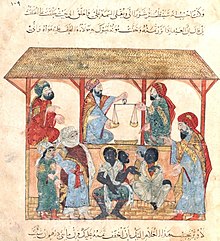 A 13th-century book illustration produced in Baghdad by al-Wasiti showing a slave-market in the town of Zabid in Yemen.
A 13th-century book illustration produced in Baghdad by al-Wasiti showing a slave-market in the town of Zabid in Yemen.The Rasulid state nurtured Yemen's commercial links with India and the Far East.[89] They profited greatly by the Red Sea transit trade via Aden and Zabid.[84] The economy also boomed due to the agricultural development programs instituted by the kings who promoted massive cultivation of palms.[84] The Rasulid kings enjoyed the support of the population of Tihama and southern Yemen, while they had to buy the loyalty of Yemen's restive northern highland tribes.[84]
The Rasulid sultans built numerous Madrasas to solidify the Shafi'i school of thought, which is still the dominant school of jurisprudence amongst Yemenis today.[90] Under their rule, Taiz and Zabid became major international centres of Islamic learning.[91] The kings themselves were educated men in their own right, who not only had important libraries but also wrote treatises on a wide array of subjects, ranging from astrology and medicine to agriculture and genealogy.[88]
The dynasty is regarded as the greatest native Yemeni state since the fall of the pre-Islamic Himyarite Kingdom.[92] They were of Turkic descent.[93] They claimed an ancient Yemenite origin to justify their rule. The Rasulids were not the first dynasty to create a fictitious genealogy for political purposes, nor were they doing anything out of the ordinary in the tribal context of Arabia.[94] By claiming descent from a solid Yemenite tribe, the Rasulids brought Yemen to a vital sense of unity in an otherwise chaotic regional milieu.[94]
They had a difficult relationship with the Mamluks of Egypt because the latter considered them a vassal state.[88] Their competition centred over the Hejaz and the right to provide kiswa of the Ka'aba in Mecca.[88] The dynasty became increasingly threatened by disgruntled family members over the problem of succession, combined by periodic tribal revolts, as they were locked in a war of attrition with the Zaydi imams in the northern highlands.[91] During the last 12 years of Rasulid rule, the country was torn between several contenders for the kingdom. The weakening of the Rasulid provided an opportunity for the Banu Taher clan to take over and establish themselves as the new rulers of Yemen in 1454 AD.[90]
Tahiride dynasty (1454–1517) Portuguese Viceroy Afonso de Albuquerque failed twice to conquer Aden, though the Portuguese Empire managed to rule Socotra until 1511.
Portuguese Viceroy Afonso de Albuquerque failed twice to conquer Aden, though the Portuguese Empire managed to rule Socotra until 1511.The Tahirids were a local clan based in Rada'a. While they were not as impressive as their predecessors, they were still keen builders. They built schools, mosques, and irrigation channels, as well as water cisterns and bridges in Zabid, Aden, Rada'a, and Juban. Their best-known monument is the Amiriya Madrasa in Rada' District, which was built in 1504.
The Tahiride were too weak either to contain the Zaydi imams or to defend themselves against foreign attacks.
Realizing how rich the Tahiride realm was, they decided to conquer it.[95] The Mamluk army, with the support of forces loyal to Zaydi Imam Al-Mutawakkil Yahya Sharaf ad-Din, conquered the entire realm of the Tahiride but failed to capture Aden in 1517. The Mamluk victory was short-lived. The Ottoman Empire conquered Egypt, hanging the last Mamluk Sultan in Cairo.[95] The Ottomans had not decided to conquer Yemen until 1538. The Zaydi highland tribes emerged as national heroes[96] by offering stiff, vigorous resistance to the Turkish occupation.[97] The Mamluks of Egypt tried to attach Yemen to Egypt and the Portuguese led by Afonso de Albuquerque, occupied the island of Socotra and made an unsuccessful attack on Aden in 1513.[98]
Modern history The Zaydis and Ottomans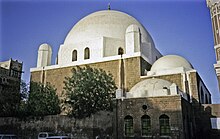 Al Bakiriyya Ottoman Mosque in Sana'a, was built in 1597
Al Bakiriyya Ottoman Mosque in Sana'a, was built in 1597 Ottoman soldiers and Yemeni locals
Ottoman soldiers and Yemeni localsThe Ottomans had two fundamental interests to safeguard in Yemen: The Islamic holy cities of Mecca and Medina, and the trade route with India in spices and textiles—both threatened, and the latter virtually eclipsed, by the arrival of the Portuguese in the Indian Ocean and the Red Sea in the early 16th century.[99] Hadım Suleiman Pasha, The Ottoman governor of Egypt, was ordered to command a fleet of 90 ships to conquer Yemen. The country was in a state of incessant anarchy and discord as Hadım Suleiman Pasha described it by saying:[100]
Yemen is a land with no lord, an empty province. It would be not only possible but easy to capture, and should it be captured, it would be master of the lands of India and send every year a great amount of gold and jewels to Constantinople.
Imam al-Mutawakkil Yahya Sharaf ad-Din ruled over the northern highlands including Sana'a, while Aden was held by the last Tahiride Sultan 'Amir ibn Dauod. Hadım Suleiman Pasha stormed Aden in 1538, killing its ruler, and extended Ottoman authority to include Zabid in 1539 and eventually Tihama in its entirety.[101] Zabid became the administrative headquarters of Yemen Eyalet.[101] The Ottoman governors did not exercise much control over the highlands. They held sway mainly in the southern coastal region, particularly around Zabid, Mocha, and Aden.[102] Of 80,000 soldiers sent to Yemen from Egypt between 1539 and 1547, only 7,000 survived.[103] The Ottoman accountant-general in Egypt remarked:[103]
We have seen no foundry like Yemen for our soldiers. Each time we have sent an expeditionary force there, it has melted away like salt dissolved in water.
The Ottomans sent yet another expeditionary force to Zabid in 1547, while Imam al-Mutawakkil Yahya Sharaf ad-Din was ruling the highlands independently. Imam al-Mutawakkil Yahya chose his son Ali to succeed him, a decision that infuriated his other son al-Mutahhar ibn Yahya.[104] Al-Mutahhar was lame, so he was not qualified for the imamate.[104] He urged Oais Pasha, the Ottoman colonial governor in Zabid, to attack his father.[105] Indeed, Ottoman troops supported by tribal forces loyal to Imam al-Mutahhar stormed Taiz and marched north toward Sana'a in August 1547. The Turks officially made Imam al-Mutahhar a Sanjak-bey with authority over 'Amran. Imam al-Mutahhar assassinated the Ottoman colonial governor and recaptured Sana'a, but the Ottomans, led by Özdemir Pasha, forced al-Mutahhar to retreat to his fortress in Thula. Özdemir Pasha effectively put Yemen under Ottoman rule between 1552 and 1560. He was considered a competent ruler given Yemen's notorious lawlessness, garrisoning the main cities, building new fortresses, and rendering secure the main routes.[106] Özdemir died in Sana'a in 1561 and was succeeded by Mahmud Pasha.
Unlike Özdemir's brief but able leadership, Mahmud Pasha was described by other Ottoman officials as a corrupt and unscrupulous governor. He used his authority to take over several castles, some of which belonged to the former Rasulid kings.[104] Mahmud Pasha killed a Sunni scholar from Ibb.[107] The Ottoman historian claimed that this incident was celebrated by the Zaydi Shia community in the northern highlands.[107] Disregarding the delicate balance of power in Yemen by acting tactlessly, he alienated different groups within Yemeni society, causing them to forget their rivalries and unite against the Turks.[106] Mahmud Pasha was displaced by Ridvan Pasha in 1564. By 1565, Yemen was split into two provinces, the highlands under the command of Ridvan Pasha and Tihama under Murad Pasha. Imam al-Mutahhar launched a propaganda campaign in which he claimed that the prophet Mohammed came to him in a dream and advised him to wage jihad against the Ottomans.[108] Al-Mutahhar led the tribes to capture Sana'a from Ridvan Pasha in 1567. When Murad tried to relieve Sana'a, highland tribesmen ambushed his unit and slaughtered all of them.[109] Over 80 battles were fought. The last decisive encounter took place in Dhamar around 1568, in which Murad Pasha was beheaded and his head sent to al-Mutahhar in Sana'a.[109][110] By 1568, only Zabid remained under the possession of the Turks.[110]
 Ruins of Thula fortress in 'Amran, where al-Mutahhar ibn Yahya barricaded himself against Ottoman attacks
Ruins of Thula fortress in 'Amran, where al-Mutahhar ibn Yahya barricaded himself against Ottoman attacksLala Kara Mustafa Pasha, the Ottoman governor of Syria, was ordered by Selim II to suppress the Yemeni rebels.[111] However, the Turkish army in Egypt was reluctant to go to Yemen due to their knowledge of the hegemony of the northern Yemenis.[111] Mustafa Pasha sent a letter with two Turkish shawishes hoping to persuade al-Mutahhar to give an apology and confirm that Mustafa Pasha did not promote any act of aggression against the Ottoman army, and state that the "ignorant Arabian" according to the Turks, acted on their own.[112] Imam al-Mutahhar refused the Ottoman offer. When Mustafa Pasha sent an expeditionary force under the command of Uthman Pasha, it was defeated with great casualties.[113] Sultan Selim II was infuriated by Mustafa's hesitation to go to Yemen. He executed a number of sanjak-beys in Egypt and ordered Sinan Pasha to lead the entire Turkish army in Egypt to reconquer Yemen.[114] Sinan Pasha was a prominent Ottoman general of Albanian origin.[110] He reconquered Aden, Taiz, and Ibb, and besieged Shibam Kawkaban in 1570 for seven months. The siege was lifted once a truce was reached.[115] Imam al-Mutahhar was pushed back, but could not be entirely overcome.[116] After al-Mutahhar's demise in 1572, the Zaydi community was not united under an imam; the Turks took advantage of their disunity and conquered Sana'a, Sa'dah, and Najran in 1583.[117] Imam al-Nasir Hassan was arrested in 1585 and exiled to Constantinople, thereby putting an end to the Yemeni rebellion.[110]
The Zaydi tribesmen in the northern highlands particularly those of Hashid and Bakil, were ever the Turkish bugbear in all Arabia.[118] The Ottomans who justified their presence in Yemen as a triumph for Islam, accused the Zaydis of being infidels.[119] Hassan Pasha was appointed governor of Yemen and enjoyed a period of relative peace from 1585 to 1597. Pupils of al-Mansur al-Qasim suggested he should claim the imamate and fight the Turks. He declined at first, but the promotion of the Hanafi school of jurisprudence at the expense of Zaydi Islam infuriated al-Mansur al-Qasim. He proclaimed the imamate in September 1597, which was the same year the Ottoman authorities inaugurated al-Bakiriyya Mosque.[117] By 1608, Imam al-Mansur (the victorious) regained control over the highlands and signed a truce for 10 years with the Ottomans.[120] Imam al-Mansur al-Qasim died in 1620. His son Al-Mu'ayyad Muhammad succeeded him and confirmed the truce with the Ottomans. In 1627, the Ottomans lost Aden and Lahej. 'Abdin Pasha was ordered to suppress the rebels, but failed, and had to retreat to Mocha.[117] Al-Mu'ayyad Muhammad expelled the Ottomans from Sana'a in 1628, only Zabid and Mocha remained under Ottoman possession. Al-Mu'ayyad Muhammad captured Zabid in 1634 and allowed the Ottomans to leave Mocha peacefully.[121] The reason behind Al-Mu'ayyad Muhammad's success was the possession of firearms by the tribes and their unity behind him.[122]
 Mocha was Yemen's busiest port in the 17th and 18th centuries
Mocha was Yemen's busiest port in the 17th and 18th centuriesIn 1632, Al-Mu'ayyad Muhammad sent an expeditionary force of 1,000 men to conquer Mecca.[123] The army entered the city in triumph and killed its governor.[123] The Ottomans were not ready to lose Mecca after Yemen, so they sent an army from Egypt to fight the Yemenites.[123] Seeing that the Turkish army was too numerous to overcome, the Yemeni army retreated to a valley outside Mecca.[124] Ottoman troops attacked the Yemenis by hiding at the wells that supplied them with water. This plan proceeded successfully, causing the Yemenis over 200 casualties, most from thirst.[124] The tribesmen eventually surrendered and returned to Yemen.[125] Al-Mu'ayyad Muhammad died in 1644. He was succeeded by Al-Mutawakkil Isma'il, another son of al-Mansur al-Qasim, who conquered Yemen in its entirety, from Asir in the north to Dhofar in the east.[126][127][128][129] During his reign, and during the reign of his successor, Al-Mahdi Ahmad (1676–1681), the imamate implemented some of the harshest discriminatory laws (ghiyar) against the Jews of Yemen, which culminated in the expulsion of all Jews (Exile of Mawza) to a hot and arid region in the Tihama coastal plain. The Qasimid state was the strongest Zaydi state to ever exist. See Yemeni Zaidi State for more information.
During that period, Yemen was the sole coffee producer in the world.[130] The country established diplomatic relations with the Safavid dynasty of Persia, Ottomans of Hejaz, Mughal Empire in India, and Ethiopia, as well. Fasilides of Ethiopia sent three diplomatic missions to Yemen, but the relations did not develop into a political alliance, as Fasilides had hoped, due to the rise of powerful feudalists in his country.[131] In the first half of the 18th century, the Europeans broke Yemen's monopoly on coffee by smuggling coffee trees and cultivating them in their own colonies in the East Indies, East Africa, the West Indies, and Latin America.[132] The imamate did not follow a cohesive mechanism for succession, and family quarrels and tribal insubordination led to the political decline of the Qasimi dynasty in the 18th century.[133] In 1728 or 1731, the chief representative of Lahej declared himself an independent sultan in defiance of the Qasimid dynasty and conquered Aden, thus establishing the Sultanate of Lahej. The rising power of the fervently Islamist Wahhabi movement on the Arabian Peninsula cost the Zaidi state its coastal possessions after 1803. The imam was able to regain them temporarily in 1818, but new intervention by the Ottoman viceroy of Egypt in 1833 again wrested the coast from the ruler in Sana'a. After 1835, the imamate changed hands with great frequency and some imams were assassinated. After 1849, the Zaidi polity descended into chaos that lasted for decades.[134]
Great Britain and the nine regions The building of the Legislative Council of Aden, built by the English in the 19th century as St. Mary's Church, was converted into the building of the Legislative Council in the 1960s, and is now a museum
The building of the Legislative Council of Aden, built by the English in the 19th century as St. Mary's Church, was converted into the building of the Legislative Council in the 1960s, and is now a museumThe British were looking for a coal depot to service their steamers en route to India. It took 700 tons of coal for a round-trip from Suez to Bombay. East India Company officials decided on Aden. The British Empire tried to reach an agreement with the Zaydi imam of Sana'a, permitting them a foothold in Mocha, and when unable to secure their position, they extracted a similar agreement from the Sultan of Lahej, enabling them to consolidate a position in Aden.[135] An incident played into British hands when, while passing Aden for trading purposes, one of their sailing ships sank and Arab tribesmen boarded it and plundered its contents. The British India government dispatched a warship under the command of Captain Stafford Bettesworth Haines to demand compensation.[135]
Haines bombarded Aden from his warship in January 1839. The ruler of Lahej, who was in Aden at the time, ordered his guards to defend the port, but they failed in the face of overwhelming military and naval power. The British managed to occupy Aden and agreed to compensate the sultan with an annual payment of 6,000 riyals.[135] The British evicted the Sultan of Lahej from Aden and forced him to accept their "protection".[135] In November 1839, 5,000 tribesmen tried to retake the town but were repulsed and 200 were killed. The British realised that Aden's prosperity depended on their relations with the neighbouring tribes, which required that they rest on a firm and satisfactory basis.[136]
The British government concluded "protection and friendship" treaties with nine tribes surrounding Aden, whereas they would remain independent from British interference in their affairs as long as they did not conclude treaties with foreigners (non-Arab colonial powers).[137] Aden was declared a free zone in 1850. With emigrants from India, East Africa, and Southeast Asia, Aden grew into a world city. In 1850, only 980 Arabs were registered as original inhabitants of the city.[138] The English presence in Aden put them at odds with the Ottomans. The Turks asserted to the British that they held sovereignty over the whole of Arabia, including Yemen as the successor of Mohammed and the Chief of the Universal Caliphate.[139]
Ottoman return The Ottoman Grand Vizier and Wāli of Yemen Ahmed Muhtar Pasha
The Ottoman Grand Vizier and Wāli of Yemen Ahmed Muhtar PashaThe Ottomans were concerned about the British expansion from the British ruled subcontinent to the Red Sea and Arabia. They returned to the Tihama in 1849 after an absence of two centuries.[140] Rivalries and disturbances continued among the Zaydi imams, between them and their deputies, with the ulema, with the heads of tribes, as well as with those who belonged to other sects. Some citizens of Sana'a were desperate to return law and order to Yemen and asked the Ottoman Pasha in Tihama to pacify the country.[141] Yemeni merchants knew that the return of the Ottomans would improve their trade, for the Ottomans would become their customers.[142] An Ottoman expedition force tried to capture Sana'a, but was defeated and had to evacuate the highlands.[143] The Opening of the Suez Canal in 1869, strengthened the Ottoman decision to remain in Yemen.[144] In 1872, military forces were dispatched from Constantinople and moved beyond the Ottoman stronghold in the lowlands (Tihama) to conquer Sana'a. By 1873, the Ottomans succeeded in conquering the northern highlands. Sana'a became the administrative capital of Yemen Vilayet.
The Ottomans learned from their previous experience and worked on the disempowerment of local lords in the highland regions. They even attempted to secularize the Yemeni society, while Yemenite Jews came to perceive themselves in Yemeni nationalist terms.[145] The Ottomans appeased the tribes by forgiving their rebellious chiefs and appointing them to administrative posts. They introduced a series of reforms to enhance the country's economic welfare. However, corruption was widespread in the Ottoman administration in Yemen. This was because only the worst of the officials were appointed because those who could avoid serving in Yemen did so.[146] The Ottomans had reasserted control over the highlands for a temporary duration.[140] The so-called Tanzimat reforms were considered heretic by the Zaydi tribes. In 1876, the Hashid and Bakil tribes rebelled against the Ottomans; the Turks had to appease them with gifts to end the uprising.[147]
The tribal chiefs were difficult to appease and an endless cycle of violence curbed Ottoman efforts to pacify the land. Ahmed Izzet Pasha proposed that the Ottoman army evacuate the highlands and confine itself to Tihama, and not unnecessarily burden itself with continuing military operation against the Zaydi tribes.[146] The hit-and-run tactics of the northern highlands tribesmen wore out the Ottoman military. They resented the Turkish Tanzimat and defied all attempts to impose a central government upon them.[144] The northern tribes united under the leadership of the House of Hamidaddin in 1890. Imam Yahya Hamidaddin led a rebellion against the Turks in 1904; the rebels disrupted the Ottoman ability to govern.[148] The revolts between 1904 and 1911 were especially damaging to the Ottomans, costing them as many as 10,000 soldiers and as much as 500,000 pounds per year.[149] The Ottomans signed a treaty with imam Yahya Hamidaddin in 1911. Under the treaty, Imam Yahya was recognized as an autonomous leader of the Zaydi northern highlands. The Ottomans continued to rule Shafi'i areas in the mid-south until their departure in 1918.
Mutawakkilite Kingdom of Yemen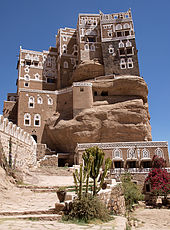 Imam Yahya Hamid Ed-Din's house near Sana'a
Imam Yahya Hamid Ed-Din's house near Sana'aImam Yahya hamid ed-Din al-Mutawakkil was ruling the northern highlands independently from 1911. After the Ottoman departure in 1918, he sought to recapture the lands of his Qasimid ancestors. He dreamed of Greater Yemen stretching from Asir to Dhofar. These schemes brought him into conflict with the de facto rulers in the territories claimed, namely the Idrisids, Ibn Saud, and the British government in Aden.[150] The Zaydi imam did not recognize the Anglo-Ottoman border agreement of 1905 on the grounds that it was made between two foreign powers occupying Yemen.[151] The border treaty effectively divided Yemen into north and south.[152] In 1915, the British signed a treaty with the Idrisids guaranteeing their security and independence if they would fight against the Turks.[153] In 1919, Imam Yahya hamid ed-Din moved southward to "liberate" the nine British protectorates. The British responded by moving quickly towards Tihama and occupying al-Hudaydah. Then they handed it over to their Idrisi allies.[154] Imam Yahya attacked the southern protectorates again in 1922. The British bombed Yahya's tribal forces using aircraft to which the tribes had no effective counter.[155]
In 1925, Imam Yahya captured al-Hudaydah from the Idrisids.[156] He continued to follow and attack the Idrisids until Asir fell under the control of the imam's forces, forcing the Idrisi to request an agreement that would enable them to administer the region in the name of the imam.[156] Imam Yahya refused the offer on the grounds that the Idrisis were of Moroccan descent. According to Imam Yahya, the Idrisis, along with the British, were nothing but recent intruders and should be driven out of Yemen permanently.[157] In 1927, Imam Yahya's forces were about 50 km (30 mi) away from Aden, Taiz, and Ibb, and were bombed by the British for five days; the imam had to pull back.[155] Small Bedouin forces, mainly from the Madh'hij confederation of Marib, attacked Shabwah but were bombed by the British and had to retreat.
The Italian Empire was the first to recognize Imam Yahya as the King of Yemen in 1926. This created a great deal of anxiety for the British, who interpreted it as recognition of Imam Yahya's claim to sovereignty over Greater Yemen, which included the Aden protectorate and Asir.[158] The Idrisis turned to Ibn Saud seeking his protection from Yahya Muhammad Hamid ed-Din. However, in 1932, the Idrisis broke their accord with Ibn Saud and went back to Imam Yahya seeking help against Ibn Saud himself, who had begun liquidating their authority and expressed his desire to annex those territories into his own Saudi domain.[159][160] Imam Yahya demanded the return of all Idrisi dominion.[159] That same year, a group of Hejazi liberals fled to Yemen and plotted to expel Ibn Saud from the former Hashemite Kingdom of Hejaz, which had been conquered by the Saudis seven years earlier. Ibn Saud appealed to Britain for aid.[161] The British government sent arms and aeroplanes .[161] The British were anxious that Ibn Saud's financial difficulties may encourage the Italian Empire to bail him out.[159] Ibn Saud suppressed the Asiri rebellion in 1933, after which the Idrisids fled to Sana'a.[161] Negotiations between the Imam Yahya Hamid ed-Din and Ibn Saud proved fruitless. After the 1934 Saudi-Yemeni war, Ibn Saud announced a ceasefire in May 1934.[161] Imam Yahya agreed to release Saudi hostages and the surrender of the Idrisis to Saudi custody. Imam Yahya ceded the three provinces of Najran, Asir, and Jazan for 20 years.[162] and signed another treaty with the British government in 1934. The imam recognized the British sovereignty over Aden protectorate for 40 years.[163] Out of fear for Hudaydah, Yahya did submit to these demands. According to Bernard Reich, Professor of Political Science and International Affairs at George Washington University, Yahya could have done better by reorganizing the Zaydi tribes of the northern highlands as his ancestors did against the Turks and British intruders and turn the lands they captured into another graveyard.[164]
Colonial Aden Queen Elizabeth II holding a sword, prepared to knight subjects in Aden in 1954
Queen Elizabeth II holding a sword, prepared to knight subjects in Aden in 1954Starting in 1890, hundreds of Yemeni people from Hajz, Al-Baetha, and Taiz migrated to Aden to work at ports, and as labourers. This helped the population of Aden once again become predominantly Arab after, having been declared a free zone, it had become mostly foreigners. During World War II, Aden had increasing economic growth and became the second-busiest port in the world after New York City.[165] After the rise of labour unions, a rift was apparent between the sectors of workers and the first signs of resistance to the occupation started in 1943.[165] Muhammad Ali Luqman founded the first Arabic club and school in Aden, and was the first to start working towards a union.[166]
The Colony of Aden was divided into an eastern colony and a western colony. Those were further divided into 23 sultanates and emirates, and several independent tribes that had no relationships with the sultanates. The deal between the sultanates and Britain detailed protection and complete control of foreign relations by the British. The Sultanate of Lahej was the only one in which the sultan was referred to as His Highness.[167] The Federation of South Arabia was created by the British to counter Arab nationalism by giving more freedom to the rulers of the nations.[168]
The North Yemen Civil War inspired many in the south to rise against the British rule. The National Liberation Front (NLF) of Yemen was formed with the leadership of Qahtan Muhammad Al-Shaabi. The NLF hoped to destroy all the sultanates and eventually unite with the Yemen Arab Republic. Most of the support for the NLF came from Radfan and Yafa, so the British launched Operation Nutcracker, which completely burned Radfan in January 1964.[169]
Two states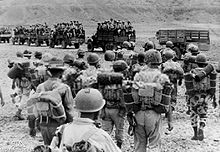 Egyptian military intervention in North Yemen, 1962
Egyptian military intervention in North Yemen, 1962Arab nationalism made an impact in some circles who opposed the lack of modernization efforts in the Mutawakkilite monarchy. This became apparent when Imam Ahmad bin Yahya died in 1962. He was succeeded by his son, but army officers attempted to seize power, sparking the North Yemen Civil War.[170] The Hamidaddin royalists were supported by Saudi Arabia, Britain, and Jordan (mostly with weapons and financial aid, but also with small military forces), whilst the military rebels were backed by Egypt. Egypt provided the rebels with weapons and financial assistance, but also sent a large military force to participate in the fighting. Israel covertly supplied weapons to the royalists to keep the Egyptian military busy in Yemen and make Nasser less likely to initiate a conflict in the Sinai. After six years of civil war, the military rebels were victorious (February 1968) and formed the Yemen Arab Republic.[171]
 British Army's counter-insurgency campaign in the British-controlled territories of South Arabia, 1967
British Army's counter-insurgency campaign in the British-controlled territories of South Arabia, 1967The revolution in the north coincided with the Aden Emergency, which hastened the end of British rule in the south. On 30 November 1967, the state of South Yemen was formed, comprising Aden and the former Protectorate of South Arabia. This socialist state was later officially known as the People's Democratic Republic of Yemen and a programme of nationalisation was begun.[172]
Relations between the two Yemeni states fluctuated between peaceful and hostile. The South was supported by the Eastern bloc. The North, however, was not able to get the same connections. In 1972, the two states fought a war. The war was resolved with a ceasefire and negotiations brokered by the Arab League, where it was declared that unification would eventually occur. In 1978, Ali Abdullah Saleh was named as president of the Yemen Arab Republic.[173] After the war, the North complained about the South's help from foreign countries. This included Saudi Arabia.[174]
In 1979, fresh fighting between the two states resumed and efforts were renewed to bring about unification.[173]
Thousands were killed in 1986 in the South Yemen Civil War. President Ali Nasser Muhammad fled to the north and was later sentenced to death for treason. A new government formed.[173]
Unification and civil war Yemen Arab Republic (in orange) and South Yemen (in blue) before 1990
Yemen Arab Republic (in orange) and South Yemen (in blue) before 1990In 1990, the two governments reached a full agreement on the joint governing of Yemen, and the countries were merged on 22 May 1990, with Saleh as president.[173] The President of South Yemen, Ali Salim al-Beidh, became vice president.[173] A unified parliament was formed and a unity constitution was agreed upon.[173] In the 1993 parliamentary election, the first held after unification, the General People's Congress won 122 of 301 seats.[175]: 309
After the invasion of Kuwait crisis in 1990, Yemen's president opposed military intervention from non-Arab states.[176] As a member of the United Nations Security Council for 1990 and 1991, Yemen abstained on a number of UNSC resolutions concerning Iraq and Kuwait[177] and voted against the "...use of force resolution." The vote outraged the U.S.[178] Saudi Arabia expelled 800,000 Yemenis in 1990 and 1991 to punish Yemen for its opposition to the intervention.[179]
In the absence of strong state institutions, elite politics in Yemen constituted a de facto form of collaborative governance, where competing tribal, regional, religious, and political interests agreed to hold themselves in check through tacit acceptance of the balance it produced.[180] The informal political settlement was held together by a power-sharing deal among three men: President Saleh, who controlled the state; major general Ali Mohsen al-Ahmar, who controlled the largest share of the Republic of Yemen Armed Forces; and Abdullah ibn Husayn al-Ahmar, figurehead of the Islamist al-Islah party and Saudi Arabia's chosen broker of transnational patronage payments to various political players,[181] including tribal sheikhs.[182][183][184][185] The Saudi payments have been intended to facilitate the tribes' autonomy from the Yemeni government and to give the Saudi government a mechanism with which to weigh in on Yemen's political decision-making.[186]
Following food riots in major towns in 1992, a new coalition government made up of the ruling parties from both the former Yemeni states was formed in 1993. However, Vice President al-Beidh withdrew to Aden in August 1993 and said he would not return to the government until his grievances were addressed. These included northern violence against his Yemeni Socialist Party, as well as the economic marginalization of the south.[187] Negotiations to end the political deadlock dragged on into 1994. The government of Prime Minister Haydar Abu Bakr Al-Attas became ineffective due to political infighting.[188]
An accord between northern and southern leaders was signed in Amman, Jordan on 20 February 1994, but this could not stop the civil war.[189] During these tensions, both the northern and southern armies (which had never integrated) gathered on their respective frontiers.[190] The May – July 1994 civil war in Yemen resulted in the defeat of the southern armed forces and the flight into exile of many Yemeni Socialist Party leaders and other southern secessionists.[citation needed] Saudi Arabia actively aided the south during the 1994 civil war.[citation needed]
Contemporary Yemen Prayers during Ramadan in Sana'a
Prayers during Ramadan in Sana'a In 2012, The Guardian reported that "Sana'a risks becoming the first capital in the world to run out of a viable water supply as Yemen's streams and natural aquifers run dry".[191]
In 2012, The Guardian reported that "Sana'a risks becoming the first capital in the world to run out of a viable water supply as Yemen's streams and natural aquifers run dry".[191]Ali Abdullah Saleh became Yemen's first directly elected president in the 1999 presidential election, winning 96.2 per cent of the vote.[175]: 310 The only other candidate, Najeeb Qahtan Al-Sha'abi, was the son of Qahtan Muhammad al-Sha'abi, a former president of South Yemen. Though a member of Saleh's General People's Congress (GPC) party, Najeeb ran as an independent.[192]
In October 2000, 17 U.S. personnel died after a suicide attack on the U.S. naval vessel USS Cole in Aden, which was subsequently blamed on al-Qaeda. After the September 11 attacks on the United States, President Saleh assured U.S. President George W. Bush that Yemen was a partner in his War on Terror. In 2001, violence surrounded a referendum, which apparently supported extending Saleh's rule and powers.
The Shia insurgency in Yemen began in June 2004 when dissident cleric Hussein Badreddin al-Houthi, head of the Zaidi Shia sect, launched an uprising against the Yemeni government. The Yemeni government alleged that the Houthis were seeking to overthrow it and to implement Shī'ite religious law. The rebels counter that they are "defending their community against discrimination" and government aggression.[193]
In 2005, at least 36 people were killed in clashes across the country between police and protesters over rising fuel prices.
In the 2006 presidential election, held on 20 September, Saleh won with 77.2% of the vote. His main rival, Faisal bin Shamlan, received 21.8%.[194][195] Saleh was sworn in for another term on 27 September.[196]
A suicide bomber killed eight Spanish tourists and two Yemenis in the province of Marib in July 2007. A series of bomb attacks occurred on police, official, diplomatic, foreign business, and tourism targets in 2008. Car bombings outside the U.S. embassy in Sana'a killed 18 people, including six of the assailants in September 2008. In 2008, an opposition rally in Sana'a demanding electoral reform was met with police gunfire.[197]
Social hierarchyThis section needs additional citations for verification. (April 2021)There is a system of social stratification in Yemen that was officially abolished at the creation of the Republic of Yemen in 1962 but, in practice, this system has not disappeared and Yemeni society is still organized around hierarchical ranks. The difference between ranks is manifested by descent and occupation and is consolidated by marriages between people of the same ranks.
There are five status groups. At the top of hierarchy, there are the religious elites, also called sada. These are then followed by the strata of judges (quad). The third hierarchical status is the qaba’il, who are the peasants who belong to tribes and who live mainly from agriculture and trading. The fourth group is called the mazayanah. This group is composed of people who had no land and provide different kinds of services such as butchers and craftsmen. Finally, at the bottom of the hierarchy are the slaves (a’bid) and even further below them Al-Akhdam, which means servants.[198]
Al-QaedaIn January 2009, the Saudi Arabian and Yemeni al-Qaeda branches merged to form Al-Qaeda in the Arabian Peninsula, which is based in Yemen, and many of its members were Saudi nationals who had been released from Guantanamo Bay.[199] Saleh released 176 al-Qaeda suspects on condition of good behaviour, but terrorist activities continued.
The Yemeni army launched a fresh offensive against the Shia insurgents in 2009, assisted by Saudi forces. Tens of thousands of people were displaced by the fighting. A new ceasefire was agreed upon in February 2010. However, by the end of the year, Yemen claimed that 3,000 soldiers had been killed in renewed fighting. The Shia rebels accused Saudi Arabia of providing support to salafi groups to suppress Zaidism in Yemen.[200]
On orders from U.S. President Barack Obama, U.S. warplanes fired cruise missiles at what officials in Washington claimed were Al Qaeda training camps in the provinces of Sana'a and Abyan on 17 December 2009.[201] Instead of hitting Al-Qaeda operatives, it hit a village, killing 55 civilians.[202] Officials in Yemen said that the attacks claimed the lives of more than 60 civilians, 28 of them children. Another airstrike was carried out on 24 December.[203]
The U.S. launched a series of drone attacks in Yemen to curb a perceived growing terror threat due to political chaos in Yemen.[204] Since December 2009, U.S. strikes in Yemen have been carried out by the U.S. military with intelligence support from the CIA.[205] The drone strikes are protested by human-rights groups who say they kill innocent civilians, and that the U.S. military and CIA drone strikes lack sufficient congressional oversight, including the choice of human targets suspected of being threats to America.[206] Controversy over U.S. policy for drone attacks mushroomed after a September 2011 drone strike in Yemen killed Anwar al-Awlaki and Samir Khan, both U.S. citizens.[207] Another drone strike in October 2011 killed Anwar's teenage son, Abdulrahman al-Awlaki.
In 2010, the Obama administration policy allowed targeting of people whose names are not known. The U.S. government increased military aid to $140 million in 2010.[208] U.S. drone strikes continued after the ousting of President Saleh.[209]
As of 2015[update], Shi'a Houthis are fighting against the Islamic State,[210] Al Qaeda,[211] and Saudi Arabia.[212] The U.S. supports the Saudi-led military intervention in Yemen against the Houthis,[213] but many in US SOCOM reportedly favor Houthis, as they have been an effective force to roll back al-Qaeda and recently ISIL in Yemen.[214] The Guardian reported that "The only groups poised to benefit from the war dragging on are the jihadis of Islamic State (ISIL) and Al-Qaeda in the Arabian Peninsula (AQAP), the latter's most powerful franchise, who are likely to gain influence amid the chaos. ISIL has claimed recent, bloody suicide bombings in Houthi mosques and Sana'a when it once had no known presence in the country, while AQAP has continued to seize territory in eastern Yemen unhindered by American drone strikes."[215] In February 2016 Al-Qaeda forces and Saudi-led coalition forces were both seen fighting Houthi rebels in the same battle.[216]
Revolution and aftermathThis section needs additional citations for verification. (October 2021)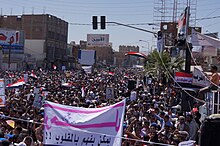 Tens of thousands of protesters marching to Sana'a University, joined for the first time by opposition parties, during the 2011–2012 Yemeni revolution
Tens of thousands of protesters marching to Sana'a University, joined for the first time by opposition parties, during the 2011–2012 Yemeni revolution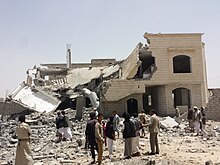 Saudi-led air strike on Sana'a, 12 June 2015
Saudi-led air strike on Sana'a, 12 June 2015The 2011 Yemeni revolution followed other Arab Spring mass protests in early 2011. The uprising was initially against unemployment, economic conditions, and corruption, as well as against the government's proposals to modify the constitution of Yemen so that Saleh's son could inherit the presidency.
In March 2011, police snipers opened fire on a pro-democracy camp in Sana'a, killing more than 50 people. In May, dozens were killed in clashes between troops and tribal fighters in Sana'a. By this point, Saleh began to lose international support. In October 2011, Yemeni human rights activist Tawakul Karman won the Nobel Peace Prize, and the UN Security Council condemned the violence and called for a transfer of power. On 23 November 2011, Saleh flew to Riyadh, in neighbouring Saudi Arabia, to sign the Gulf Co-operation Council plan for political transition, which he had previously spurned. Upon signing the document, he agreed to legally transfer the office and powers of the presidency to his deputy, Vice President Abdrabbuh Mansur Hadi.[217]
Hadi took office for a two-year term upon winning the uncontested presidential elections in February 2012.[218] A unity government – including a prime minister from the opposition – was formed. Al-Hadi would oversee the drafting of a new constitution, followed by parliamentary and presidential elections in 2014. Saleh returned in February 2012. In the face of objections from thousands of street protesters, parliament granted him full immunity from prosecution. Saleh's son, General Ahmed Ali Abdullah Saleh, continues to exercise a strong hold on sections of the military and security forces.
AQAP claimed responsibility for a February 2012 suicide attack on the presidential palace that killed 26 Republican Guards on the day that President Hadi was sworn in. AQAP was also behind a suicide bombing that killed 96 soldiers in Sana'a three months later. In September 2012, a car bomb attack in Sana'a killed 11 people, a day after a local al-Qaeda leader Said al-Shihri was reported killed in the south.
By 2012, there has been a "small contingent of U.S. special-operations troops" – in addition to CIA and "unofficially acknowledged" U.S. military presence – in response to increasing terror attacks by AQAP on Yemeni citizens.[219] Many analysts have pointed out the former Yemeni government role in cultivating terrorist activity in the country.[220] Following the election of the new president, Abdrabbuh Mansur Hadi, the Yemeni military was able to push Ansar al-Sharia back and recapture the Shabwah Governorate.
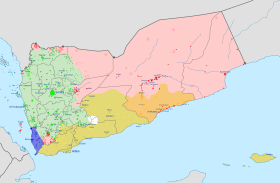 Current (November 2021) political and military control in ongoing Yemeni Civil War (2014–present)
Current (November 2021) political and military control in ongoing Yemeni Civil War (2014–present)
Controlled by the Government of Yemen (under the Presidential Leadership Council since April 2022) and alliesControlled by Houthis-led Supreme Political CouncilControlled by Al-Qaeda (AQAP) and Islamic State of Iraq and the Levant-affiliated Ansar al-ShariaControlled by the UAE-backed Southern Transitional CouncilThe central government in Sana'a remained weak, staving off challenges from southern separatists and Shia rebels as well as AQAP. The Shia insurgency intensified after Hadi took power, escalating in September 2014 as anti-government forces led by Abdul-Malik al-Houthi swept into the capital and forced Hadi to agree to a "unity" government.[221] The Houthis then refused to participate in the government,[222] although they continued to apply pressure on Hadi and his ministers, even shelling the president's private residence and placing him under house arrest,[223] until the government's mass resignation in January 2015.[224] The following month, the Houthis dissolved parliament and declared that a Revolutionary Committee under Mohammed Ali al-Houthi was the interim authority in Yemen. Abdul-Malik al-Houthi, a cousin of the new acting president, called the takeover a "glorious revolution". However, the "constitutional declaration" of 6 February 2015 was widely rejected by opposition politicians and foreign governments, including the United Nations.[225]
Hadi managed to flee from Sana'a to Aden, his hometown and stronghold in the south, on 21 February 2015. He promptly gave a televised speech rescinding his resignation, condemning the coup, and calling for recognition as the constitutional president of Yemen.[226] The following month, Hadi declared Aden Yemen's "temporary" capital.[227][228] The Houthis, however, rebuffed an initiative by the Gulf Cooperation Council and continued to move south toward Aden. All U.S. personnel were evacuated and President Hadi was forced to flee the country to Saudi Arabia. On 26 March 2015, Saudi Arabia announced Operation Decisive Storm and began airstrikes and announced its intentions to lead a military coalition against the Houthis, whom they claimed were being aided by Iran, and began a force buildup along the Yemeni border. The coalition included the United Arab Emirates, Kuwait, Qatar, Bahrain, Jordan, Morocco, Sudan, Egypt, and Pakistan. The United States announced that it was assisting with intelligence, targeting, and logistics. Saudi Arabia and Egypt would not rule out ground operations. After Hadi troops took control of Aden from Houthis, jihadist groups became active in the city, and some terrorist incidents were linked to them such as Missionaries of Charity attack in Aden on 4 March 2016. Since February 2018, Aden has been seized by the UAE-backed separatist Southern Transitional Council.[229]
Yemen has been suffering from a famine since 2016 as a result of the Civil War. More than 50,000 children in Yemen died from starvation in 2017.[230][231] The famine is being compounded by an outbreak of cholera that has affected more than one million people.[232] The Saudi Arabian-led intervention in Yemen and blockade of Yemen have contributed to the famine and cholera epidemic.[233][234] The UN estimated that by the end of 2021, the war in Yemen would have caused over 377,000 deaths, and roughly 70% of deaths were children under age 5.[235][236]
On 4 December 2017, deposed strongman and former president Ali Abdullah Saleh, accused of treason, was assassinated by Houthis whilst attempting to flee clashes near rebel-held Sana'a between Houthi and pro-Saleh forces.[237]
After losing the support of the Saudi-led coalition, Yemen's President Abd Rabbuh Mansur Hadi resigned and Presidential Leadership Council took power in April 2022.[238]
^ McLaughlin (2008), p. 4 ^ Kenneth Anderson Kitchen (2003). On the Reliability of the Old Testament. Wm. B. Eerdmans Publishing. p. 594. ISBN 0-8028-4960-1. ^ Quran 27:6–93 ^ Quran 34:15–18 ^ Geoffrey W. Bromiley (1979). The International Standard Bible Encyclopedia. Vol. 4. p. 254. ISBN 0-8028-3784-0. ^ Nicholas Clapp (2002). Sheba: Through the Desert in Search of the Legendary Queen. Houghton Mifflin Harcourt. p. 204. ISBN 0-618-21926-9. ^ P. M. Holt; Peter Malcolm Holt; Ann K. S. Lambton; Bernard Lewis (21 April 1977). The Cambridge History of Islam. Cambridge University Press. p. 7. ^ Korotayev, Andrey (1995). Ancient Yemen: some general trends of evolution of the Sabaic language and Sabaean culture. Oxford: Oxford University Press. ISBN 0-19-922237-1. ^ McLaughlin (2008), p. 5 ^ Jerry R. Rogers; Glenn Owen Brown; Jürgen Garbrecht (1 January 2004). Water Resources and Environmental History. ASCE Publications. p. 36. ISBN 0-7844-7550-4. ^ Werner Daum (1987). Yemen: 3000 Years of Art and Civilization in Arabia Felix. Pinguin-Verlag. p. 73. ISBN 3-7016-2292-2. ^ "The kingdoms of ancient South Arabia". British Museum. Archived from the original on 3 December 2013. Retrieved 7 February 2014. ^ Jawād ʻAlī (1968) [Digitized 17 February 2007]. الـمـفـصـّل في تـاريـخ العـرب قبـل الإسـلام [Detailed history of Arabs before Islam] (in Arabic). Vol. 2. Dār al-ʻIlm lil-Malāyīn. p. 19. ^ George Hatke (2013). Aksum and Nubia: Warfare, Commerce, and Political Fictions in Ancient Northeast Africa. NYU Press. p. 19. ISBN 978-0-8147-6283-7. ^ Teshale Tibebu (1995). The making of modern Ethiopia: 1896–1974. Lawrenceville, NJ: Red Sea Press. p. xvii. ISBN 1-56902-001-9. ^ Peter R. Schmidt (2006). Historical Archaeology in Africa: Representation, Social Memory, and Oral Traditions. Rowman Altamira. p. 281. ISBN 0-7591-1415-3. ^ Ali Aldosari (2007). Middle East, Western Asia, and Northern Africa. Marshall Cavendish. p. 24. ISBN 978-0-7614-7571-2. ^ D. T. Potts (2012). A Companion to the Archaeology of the Ancient Near East. John Wiley & Sons. p. 1047. ISBN 978-1-4051-8988-0. ^ Negev, Avraham; Gibson, Shimon, eds. (2001). Dedan. Archaeological Encyclopedia of the Holy Land. New York and London: Continuum. p. 137. ISBN 0-8264-1316-1. Retrieved 26 July 2021. (Snippet view). ^ Lionel Casson (2012). The Periplus Maris Erythraei: Text with Introduction, Translation, and Commentary. Princeton University Press. p. 150. ISBN 978-1-4008-4320-6. ^ Peter Richardson (1999). Herod: King of the Jews and Friend of the Romans. Continuum. p. 230. ISBN 0-567-08675-5. ^ Hârun Yahya (1999). Perished Nations. Global Yayincilik. p. 115. ISBN 1-897940-87-4. ^ Jan Retso (2013). The Arabs in Antiquity: Their History from the Assyrians to the Umayyads. Routledge. p. 402. ISBN 978-1-136-87282-2. ^ Clifford Edmund Bosworth (1989). The Encyclopedia of Islam. Vol. 6. Brill Archive. p. 561. ISBN 9004090827. ^ Stuart Munro-Hay (2002). Ethiopia, the Unknown Land: A Cultural and Historical Guide. I. B. Tauris. p. 236. ISBN 1-86064-744-8. ^ G. Johannes Botterweck; Helmer Ringgren (1979). Theological Dictionary of the Old Testament. Vol. 3. Wm. B. Eerdmans Publishing. p. 448. ISBN 0-8028-2327-0. ^ Jawād ʻAlī (1968) [Digitized 17 February 2007]. الـمـفـصـّل في تـاريـخ العـرب قبـل الإسـلام [Detailed history of Arabs before Islam] (in Arabic). Vol. 2. Dār al-ʻIlm lil-Malāyīn. p. 482. ^ Albert Jamme (1962). Inscriptions From Mahram Bilqis (Marib). Baltimore. p. 392. ^ Dieter Vogel; Susan James (1990). Yemen. APA Publications. p. 34. ^ Klaus Schippmann (2001). Ancient South Arabia: from the Queen of Sheba to the advent of Islam. Markus Wiener Publishers. pp. 52–53. ISBN 1-55876-236-1. ^ Francis E. Peters (1994). Muhammad and the Origins of Islam. SUNY Press. p. 48. ISBN 0-7914-1875-8. ^ Scott Johnson (1 November 2012). The Oxford Handbook of Late Antiquity. Oxford University Press. p. 265. ISBN 978-0-19-533693-1. ^ a b Shlomo Sand (2010). The Invention of the Jewish People. Verso. p. 193. ISBN 978-1-84467-623-1. ^ Y. M. Abdallah (1987). "The Inscription CIH 543: A New Reading Based on the Newly-Found Original". In C. Robin & M. Bafaqih (eds.). Sayhadica: Recherches Sur Les Inscriptions De l'Arabie Préislamiques Offertes Par Ses Collègues Au Professeur A.F.L. Beeston. Paris: Librairie Orientaliste Paul Geuthner S.A. pp. 4–5. ^ Raphael Patai; Jennifer Patai (1989). The Myth of the Jewish Race. Wayne State University Press. p. 63. ISBN 0-8143-1948-3. ^ Uwidah Metaireek Al-Juhany (2002). Najd before the Salafi reform movement: social, political and religious conditions during the three centuries preceding the rise of the Saudi state. Ithaca Press. p. 171. ISBN 0-86372-401-9. ^ Scott Johnson (1 November 2012). The Oxford Handbook of Late Antiquity. Oxford University Press. p. 266. ISBN 978-0-19-533693-1. ^ a b c Scott Johnson (1 November 2012). The Oxford Handbook of Late Antiquity. Oxford University Press. p. 282. ISBN 978-0-19-533693-1. ^ Irfan Shahîd (1989). Byzantium and the Arabs in the 5th Century. Dumbarton Oaks. p. 65. ISBN 0-88402-152-1. ^ a b Ken Blady (2000). Jewish Communities in Exotic Places. Jason Aronson. p. 9. ISBN 1-4616-2908-X. ^ Eric Maroney (2010). The Other Zions: The Lost Histories of Jewish Nations. Rowman & Littlefield. p. 94. ISBN 978-1-4422-0045-6. ^ Joan Comay; Lavinia Cohn-Sherbok (2 November 1995). Who's who in Jewish history after the period of the Old Testament. Oxford University Press. p. 391. ISBN 0-19-521079-4. ^ P. Yule (2013). "A Late Antique Christian king from Ḥimyar, southern Arabia, Antiquity, 87". Antiquity Bulletin. Antiquity Publications: 1134. ISSN 0003-598X.; D. W. Phillipson (2012). Foundations of an African Civilisation: Aksum and the Northern Horn, 1000 BC – 1300 AD. Boydell & Brewer Ltd. p. 204. ISBN 978-1-84701-041-4. ^ a b Angelika Neuwirth; Nicolai Sinai; Michael Marx (2010). The Quran in Context: Historical and Literary Investigations Into the Quranic Milieu. BRILL. p. 49. ISBN 978-9004176881. ^ a b c Scott Johnson (1 November 2012). The Oxford Handbook of Late Antiquity. Oxford University Press. p. 293. ISBN 978-0-19-533693-1. ^ Scott Johnson (1 November 2012). The Oxford Handbook of Late Antiquity. Oxford University Press. p. 285. ISBN 978-0-19-533693-1. ^ Scott Johnson (1 November 2012). The Oxford Handbook of Late Antiquity. Oxford University Press. p. 298. ISBN 978-0-19-533693-1. ^ Sabarr Janneh. Learning From the Life of Prophet Muhammad. AuthorHouse. p. 17. ISBN 1-4678-9966-6. ^ Abd al-Muhsin Madʼaj M. Madʼaj The Yemen in Early Islam (9–233/630–847): A Political History p. 12 Ithaca Press, 1988 ISBN 0863721028 ^ Wilferd Madelung The Succession to Muhammad: A Study of the Early Caliphate p. 199 Cambridge University Press, 15 October 1998 ISBN 0521646960 ^ Ṭabarī The History of al-Tabari Vol. 12: The Battle of al-Qadisiyyah and the Conquest of Syria and Palestine A.D. 635–637/A.H. 14–15 pp. 10–11 SUNY Press, 1992 ISBN 0791407330 ^ Idris El Hareir The Spread of Islam Throughout the World p. 380 UNESCO, 2011 ISBN 9231041533 ^ Nejla M. Abu Izzeddin The Druzes: A New Study of Their History, Faith, and Society BRILL, 1993 ISBN 9004097058 ^ Hugh Kennedy The Armies of the Caliphs: Military and Society in the Early Islamic State p. 33 Routledge, 17 June 2013 ISBN 1134531133 ^ a b Andrew Rippin The Islamic World p. 237 Routledge, 23 October 2013 ISBN 1136803432 ^ a b Paul Wheatley The Places Where Men Pray Together: Cities in Islamic Lands, Seventh Through the Tenth Centuries p. 128 University of Chicago Press, 2001 ISBN 0226894282 ^ Kamal Suleiman Salibi A History of Arabia p. 108 Caravan Books, 1980 OCLC Number: 164797251 ^ Paul Lunde, Alexandra Porter (2004). Trade and travel in the Red Sea Region: proceedings of Red Sea project I held in the British Museum, October 2002. Archaeopress. p. 20. ISBN 1-84171-622-7. in 976–77 AD[...] the then ruler of Yemen received slaves, as well as amber and leopard skins from the chief of the Dahlak islands (off the coast from Massawa). ^ Stephen W. Day Regionalism and Rebellion in Yemen: A Troubled National Union p. 31 Cambridge University Press, 2012 ISBN 1107022150 ^ Gerhard Lichtenthäler Political Ecology and the Role of Water: Environment, Society and Economy in Northern Yemen p. 55 Ashgate Publishing, Ltd. 2003 ISBN 0754609081 ^ First Encyclopaedia of Islam: 1913–1936 p. 145 BRILL, 1993 ISBN 9004097961 ^ E. J. Van Donzel Islamic Desk Reference p. 492 BRILL, 1994 ISBN 9004097384 ^ Muhammed Abdo Al-Sururi (1987). الحياة السياسية ومظاهر الحضارة في اليمن في عهد الدول المستقلة [political life and aspects of civilization in Yemen during the reign of Independent States] (in Arabic). University of Sana'a. p. 237. ^ Henry Cassels Kay (1999). Yaman its early medieval history. Adegi Graphics LLC. p. 14. ISBN 1-4212-6464-1. ^ J. D. Fage, Roland Anthony Oliver The Cambridge History of Africa, Volume 3 p. 119 Cambridge University Press,1977 ISBN 0521209811 ^ William Charles Brice (1981), An Historical Atlas of Islam [cartographic Material], BRILL, p. 338, ISBN 9004061169 ^ Farhad Daftary Ismailis in Medieval Muslim Societies: A Historical Introduction to an Islamic Community p. 92 I. B. Tauris, 2005 ISBN 1845110919 ^ Farhad Daftary The Isma'ilis: Their History and Doctrines p. 199 Cambridge University Press, 2007 ISBN 1139465783 ^ a b Fatima Mernissi The Forgotten Queens of Islam p. 14 U of Minnesota Press, 1997 ISBN 0816624399 ^ Mohammed Abdo Al-Sururi (1987). الحياة السياسية ومظاهر الحضارة في اليمن في عهد الدو المستقلة [political life and aspects of civilization in Yemen during the reign of Independent States] (in Arabic). University of Sana'a. p. 237. ^ Farhad Daftary Ismailis in Medieval Muslim Societies: A Historical Introduction to an Islamic Community p. 93 I. B. Tauris, 2005 ISBN 1845110919 ^ a b Steven C. Caton Yemen p. 51 ABC-CLIO, 2013 ISBN 159884928X ^ Bonnie G. Smith (2008). The Oxford Encyclopedia of Women in World History (in Arabic). Vol. 4. Oxford University Press. p. 163. ISBN 978-0-19-514890-9. ^ Mohammed Abdo Al-Sururi (1987). الحياة السياسية ومظاهر الحضارة في اليمن في عهد الدو المستقلة [political life and aspects of civilization in Yemen during the reign of Independent States] (in Arabic). University of Sana'a. p. 414. ^ Mohammed Abdo Al-Sururi (1987). الحياة السياسية ومظاهر الحضارة في اليمن في عهد الدو المستقلة [political life and aspects of civilization in Yemen during the reign of Independent States] (in Arabic). University of Sana'a. p. 303. ^ Alexander Mikaberidze (2011). Conflict and Conquest in the Islamic World: A Historical Encyclopedia: A Historical Encyclopedia. ABC-CLIO. p. 159. ISBN 978-1-59884-337-8. ^ Mohammed Abdo Al-Sururi (1987). الحياة السياسية ومظاهر الحضارة في اليمن في عهد الدو المستقلة [political life and aspects of civilization in Yemen during the reign of Independent States] (in Arabic). University of Sana'a. p. 311. ^ a b Farhad Daftary (2007). The Isma'ilis: Their History and Doctrines. Cambridge University Press. p. 260. ISBN 978-1-139-46578-6. ^ Josef W. Meri (2004). Medieval Islamic Civilization. Psychology Press. p. 871. ISBN 0-415-96690-6. ^ Mohammed Abdo Al-Sururi (1987). الحياة السياسية ومظاهر الحضارة في اليمن في عهد الدول المستقلة [political life and aspects of civilization in Yemen during the reign of Independent States] (in Arabic). University of Sana'a. p. 350. ^ Mohammed Abdo Al-Sururi (1987). الحياة السياسية ومظاهر الحضارة في اليمن في عهد الدول المستقلة [political life and aspects of civilization in Yemen during the reign of Independent States] (in Arabic). University of Sana'a. p. 354. ^ Mohammed Abdo Al-Sururi (1987). الحياة السياسية ومظاهر الحضارة في اليمن في عهد الدول المستقلة [political life and aspects of civilization in Yemen during the reign of Independent States] (in Arabic). University of Sana'a. p. 371. ^ a b Mohammed Abdo Al-Sururi (1987). الحياة السياسية ومظاهر الحضارة في اليمن في عهد الدول المستقلة [political life and aspects of civilization in Yemen during the reign of Independent States] (in Arabic). University of Sana'a. p. 407. ^ a b c d e Alexander D. Knysh (1999). Ibn 'Arabi in the Later Islamic Tradition: The Making of a Polemical Image in Medieval Islam. SUNY Press. p. 230. ISBN 1-4384-0942-7. ^ a b Abdul Ali (1996). Islamic Dynasties of the Arab East: State and Civilization During the Later Medieval Times. M.D. Publications Pvt. Ltd. p. 84. ISBN 8175330082. ^ Abdul Ali (1996). Islamic Dynasties of the Arab East: State and Civilization During the Later Medieval Times. M.D. Publications Pvt. Ltd. p. 85. ISBN 8175330082. ^ a b c d Abdul Ali (1996). Islamic Dynasties of the Arab East: State and Civilization During the Later Medieval Times. M.D. Publications Pvt. Ltd. p. 86. ISBN 8175330082. ^ a b c d Josef W. Meri; Jere L. Bacharach (2006). Medieval Islamic Civilization: L-Z, index. Taylor & Francis. p. 669. ISBN 0-415-96692-2. ^ David J Wasserstein; Ami Ayalon (2013). Mamluks and Ottomans: Studies in Honour of Michael Winter. Routledge. p. 201. ISBN 978-1-136-57917-2. ^ a b David J Wasserstein; Ami Ayalon (2013). Mamluks and Ottomans: Studies in Honour of Michael Winter. Routledge. p. 201. ISBN 978-1-136-57917-2. ^ a b Alexander D. Knysh (1999). Ibn 'Arabi in the Later Islamic Tradition: The Making of a Polemical Image in Medieval Islam. SUNY Press. p. 231. ISBN 1-4384-0942-7. ^ Abdul Ali (1996). Islamic Dynasties of the Arab East: State and Civilization During the Later Medieval Times. M.D. Publications Pvt. Ltd. p. 94. ISBN 8175330082. ^ Jane Hathaway (2003). A Tale of Two Factions: Myth, Memory, and Identity in Ottoman Egypt and Yemen. SUNY Press. ISBN 0-7914-5883-0. ^ a b ^ Daniel Martin Varisco (1993). the Unity of the Rasulid State under al-Malik al-Muzaffar. Revue du monde musulman et de la Méditerranée p. 21 Volume 67 ^ a b Steven C. Caton Yemen p. 59 ABC-CLIO, 2013 ISBN 159884928X ^ Abdul Ali (1996). Islamic Dynasties of the Arab East: State and Civilization During the Later Medieval Times. M.D. Publications Pvt. Ltd. p. 94. ISBN 8175330082. ^ Bernard Haykel (2003). Revival and Reform in Islam: The Legacy of Muhammad Al-Shawkani. Cambridge University Press. p. 30. ISBN 0-521-52890-9. ^ Halil İnalcık; Donald Quataert (1994). An Economic and Social History of the Ottoman Empire, 1300–1914. Cambridge University Press. p. 320. ISBN 0-521-34315-1. ^ Nahrawālī, Muḥammad ibn Aḥmad (6 September 2002). البرق اليماني في الفتح العثماني [Lightning Over Yemen: A History of the Ottoman Campaign in Yemen, 1569–71]. Translated by Smith, Clive. I. B. Tauris. p. 2. ISBN 978-1-86064-836-6. ^ Giancarlo Casale (2010). The Ottoman Age of Exploration. Oxford University Press. p. 43. ISBN 978-0-19-979879-7. ^ a b Nahrawālī (2002), p. 88 ^ Jane Hathaway (2012). A Tale of Two Factions: Myth, Memory, and Identity in Ottoman Egypt and Yemen. SUNY Press. p. 83. ISBN 978-0-7914-8610-8. ^ a b Robert W. Stookey (1978). Yemen: the politics of the Yemen Arab Republic. Westview Press. p. 134. ISBN 0-89158-300-9. ^ a b c Nahrawālī (2002), p. 95 ^ R. B. Serjeant; Ronald Lewcock (1983). Sana: An Arabian Islamic City. World of Islam Festival Pub. Co. p. 70. ISBN 0-905035-04-6. ^ a b Halil İnalcık; Donald Quataert (1984). An Economic and Social History of the Ottoman Empire, 1300–1914. Cambridge University Press. p. 333. ISBN 0-521-34315-1. ^ a b Nahrawālī (2002), p. 132 ^ Nahrawālī (2002), p. 134 ^ a b Nahrawālī (2002), p. 180 ^ a b c d Abdul Ali (1996). Islamic Dynasties of the Arab East: State and Civilization During the Later Medieval Times. M.D. Publications Pvt. Ltd. p. 103. ISBN 8175330082. ^ a b Nahrawālī (2002), p. 198 ^ Nahrawālī (2002), p. 200 ^ Nahrawālī (2002), p. 208 ^ Nahrawālī (2002), p. 210 ^ Nancy Um (2009). The merchant houses of Mocha: trade and architecture in an Indian Ocean port. University of Washington Press. p. 19. ISBN 978-0-295-98910-5. ^ Robert W. Stookey (1978). Yemen: the politics of the Yemen Arab Republic. Westview Press. p. 141. ISBN 0-89158-300-9. ^ a b c Michel Tuchscherer (July 2000). "Chronologie du Yémen (1506–1635)', Chroniques yémenites". Arabian Humanities. Revue Internationale d'Archéologie et de Sciences Sociales Sur la Péninsule Arabique/International Journal of Archaeology and Social Sciences in the Arabian Peninsula (8). doi:10.4000/cy.11. Retrieved 3 February 2014. ^ Harold F. Jacob (2007). Kings of Arabia: The Rise and Set of the Turkish Sovranty in the Arabian Peninsula. Garnet & Ithaca Press. p. 70. ISBN 978-1-85964-198-9. ^ Nahrawālī (2002), p. 197 ^ 'Abd al-Samad al-Mawza'i (1986). al-Ihsan fî dukhûl Mamlakat al-Yaman taht zill Adalat al-'Uthman [الإحسان في دخول مملكة اليمن تحت ظل عدالة آل عثمان] (in Arabic). New Generation Library. pp. 99–105. ^ Amira Maddah (1982). l-Uthmâniyyun wa-l-Imam al-Qasim b. Muhammad b. Ali fo-l-Yaman [العثمانيون والإمام القاسم بن محمد في اليمن] (in Arabic). p. 839. ^ Musflafâ Sayyid Salim (1974). al-Fath al-'Uthmani al-Awwal li-l-Yaman [الفتح العثماني الأول لليمن] (in Arabic). p. 357. ^ a b c Accounts and Extracts of the Manuscripts in the Library of the King of France. Vol. 2. R. Faulder. 1789. p. 75. ^ a b Accounts and Extracts of the Manuscripts in the Library of the King of France. Vol. 2. R. Faulder. 1789. p. 76. ^ Accounts and Extracts of the Manuscripts in the Library of the King of France. Vol. 2. R. Faulder. 1789. p. 78. ^ Kjetil Selvik; Stig Stenslie (2011). Stability and Change in the Modern Middle East. I. B. Tauris. p. 90. ISBN 978-1-84885-589-2. ^ Anna Hestler; Jo-Ann Spilling (2010). Yemen. Marshall Cavendish. p. 23. ISBN 978-0-7614-4850-1. ^ Richard N. Schofield (1994). Territorial foundations of the Gulf states. UCL Press. p. 90. ISBN 1-85728-121-7. ^ Burrowes (2010), p. 295 ^ Nelly Hanna (2005). Society and Economy in Egypt and the Eastern Mediterranean, 1600–1900: Essays in Honor of André Raymond. American Univ in Cairo Press. p. 124. ISBN 9774249372. ^ Roman Loimeier (2013). Muslim Societies in Africa: A Historical Anthropology. Indiana University Press. p. 193. ISBN 978-0-253-00797-1. ^ Marta Colburn (2002). The Republic of Yemen: Development Challenges in the 21st Century. CIIR. p. 15. ISBN 1-85287-249-7. ^ Ari Ariel (2013). Jewish-Muslim Relations and Migration from Yemen to Palestine in the Late Nineteenth and Twentieth Centuries. BRILL. p. 24. ISBN 978-9004265370. ^ R.L. Playfair (1859), A History of Arabia Felix or Yemen. Bombay; R.B. Serjeant & R. Lewcock (1983), San'a': An Arabian Islamic City. London. ^ a b c d Caesar E. Farah (2002). The Sultan's Yemen: 19th-Century Challenges to Ottoman Rule. I. B. Tauris. p. 120. ISBN 1-86064-767-7. ^ Caesar E. Farah (2002). The Sultan's Yemen: 19th-Century Challenges to Ottoman Rule. I. B. Tauris. p. 124. ISBN 1-86064-767-7. ^ Caesar E. Farah (2002). The Sultan's Yemen: 19th-Century Challenges to Ottoman Rule. I. B. Tauris. p. 121. ISBN 1-86064-767-7. ^ R. J. Gavin (1975). Aden Under British Rule, 1839–1967. C. Hurst & Co. Publishers. p. 60. ISBN 0-903983-14-1. ^ Caesar E. Farah (2002). The Sultan's Yemen: 19th-Century Challenges to Ottoman Rule. I. B. Tauris. p. 132. ISBN 1-86064-767-7. ^ a b Caesar E. Farah (2002). The Sultan's Yemen: 19th-Century Challenges to Ottoman Rule. I. B. Tauris. p. 120. ISBN 1-86064-767-7. ^ Reeva S. Simon; Michael Menachem Laskier; Sara Reguer (2013). The Jews of the Middle East and North Africa in Modern Times. Columbia University Press. p. 390. ISBN 978-0-231-50759-2. ^ Caesar E. Farah (2002). The Sultan's Yemen: 19th-Century Challenges to Ottoman Rule. I. B. Tauris. p. 59. ISBN 1-86064-767-7. ^ Derryl N. Maclean; Sikeena Karmali Ahmed (2012). Cosmopolitanisms in Muslim Contexts: Perspectives from the Past. Edinburgh University Press. p. 54. ISBN 978-0-7486-4456-8. ^ a b B. Z. Eraqi Klorman (1993). The Jews of Yemen in the Nineteenth Century: A Portrait of a Messianic Community. BRILL. p. 11. ISBN 9004096841. ^ Ari Ariel (2013). Jewish-Muslim Relations and Migration from Yemen to Palestine in the Late Nineteenth and Twentieth Centuries. BRILL. p. 37. ISBN 978-9004265370. ^ a b Doğan Gürpınar (2013). Ottoman/Turkish Visions of the Nation, 1860–1950. Palgrave Macmillan. p. 71. ISBN 978-1-137-33421-3. ^ Caesar E. Farah (2002). The Sultan's Yemen: 19th-Century Challenges to Ottoman Rule. I. B. Tauris. p. 96. ISBN 1-86064-767-7. ^ B. Z. Eraqi Klorman (1993). The Jews of Yemen in the Nineteenth Century: A Portrait of a Messianic Community. BRILL. p. 12. ISBN 9004096841. ^ Eugene L. Rogan (2002). Frontiers of the State in the Late Ottoman Empire: Transjordan, 1850–1921. Cambridge University Press. ISBN 0-521-89223-6. ^ Clive Leatherdale (1983). Britain and Saudi Arabia, 1925–1939: The Imperial Oasis. Psychology Press. p. 140. ISBN 0-7146-3220-1. ^ Nikshoy C. Chatterji (1973). Muddle of the Middle East, Volume 1. Abhinav Publications. p. 197. ISBN 0-391-00304-6. ^ Harold F. Jacob (2007). Kings of Arabia: The Rise and Set of the Turkish Sovereignty in the Arabian Peninsula. Garnet & Ithaca Press. p. 82. ISBN 978-1-85964-198-9. ^ James Minahan (2002). Encyclopedia of the Stateless Nations: A-C. Greenwood Publishing Group. p. 195. ISBN 0-313-32109-4. ^ Bernard Reich (1990). Political Leaders of the Contemporary Middle East and North Africa: A Biographical Dictionary. Greenwood Publishing Group. p. 508. ISBN 0-313-26213-6. ^ a b Paul Dresch (2000). A History of Modern Yemen. Cambridge University Press. p. 34. ISBN 0-521-79482-X. ^ a b Bernard Reich (1990). Political Leaders of the Contemporary Middle East and North Africa: A Biographical Dictionary. Greenwood Publishing Group. p. 509. ISBN 0-313-26213-6. ^ Ameen Rihani (1960). Kings of the Arabs [Muluk al-Arab]. Beirut: Dar al-Rihani. pp. 214–216. ^ Massimiliano Fiore (2010). Anglo-Italian Relations in the Middle East, 1922–1940. Ashgate Publishing, Ltd. p. 21. ISBN 978-0-7546-9747-3. ^ a b c Madawi al-Rasheed (2002). A History of Saudi Arabia. Cambridge University Press. p. 101. ISBN 0-521-64412-7. ^ Bernard Reich (1990). Political Leaders of the Contemporary Middle East and North Africa: A Biographical Dictionary. Greenwood Publishing Group. p. 509. ISBN 978-0-313-26213-5. ^ a b c d Madawi al-Rasheed (April 2010). A History of Saudi Arabia. Cambridge University Press. p. 97. ISBN 978-0-521-76128-4. ^ Raymond A. Hinnebusch; Anoushiravan Ehteshami (2002). The Foreign Policies of Middle East States. Lynne Rienner Publishers. p. 262. ISBN 1-58826-020-8. ^ Glen Balfour-Paul (1994). The End of Empire in the Middle East: Britain's Relinquishment of Power in Her Last Three Arab Dependencies. Cambridge University Press. p. 60. ISBN 0-521-46636-9. ^ Bernard Reich (1990). Political Leaders of the Contemporary Middle East and North Africa: A Biographical Dictionary. Greenwood Publishing Group. p. 510. ISBN 978-0-313-26213-5. ^ a b Kiren Aziz Chaudhry The Price of Wealth: Economies and Institutions in the Middle East p. 117 ^ Ulrike Freitag Indian Ocean Migrants and State Formation in Hadhramaut: Reform ^ Don Peretz The Middle East Today p. 490 ^ The Middle East Today By Don Peretz p. 491 ^ Human Rights Human Wrongs By M. S. Gill p. 48 ^ F. Gregory Gause (1990). Saudi-Yemeni Relations: Domestic Structures and Foreign Influence. Columbia University Press. p. 60. ISBN 978-0-231-07044-7. Retrieved 22 February 2013. ^ Dresch, Paul (2000). A History of Modern Yemen. Cambridge University Press. p. 115. ISBN 978-0-521-79482-4. Retrieved 22 February 2013. ^ Schmitthoff, Clive Macmillan, Clive M. Schmitthoff's select essays on international trade law p. 390 ^ a b c d e f "Yemen profile (timeline)". BBC. 26 October 2013. Retrieved 14 December 2013. 1978 – Ali Abdullah Saleh named as president of YAR. ^ Dresch, Paul (2000). A History of Modern Yemen. Cambridge University Press. pp. 120–124. ^ a b Nohlen, Dieter; Grotz, Florian; Hartmann, Christof, eds. (2001). Elections in Asia: A data handbook, Volume I. Oxford: Oxford University Press. pp. 309–310. ISBN 978-0-19-924958-9. Retrieved 7 April 2011. ^ "Persian Gulf War, Desert Storm – War with Iraqi". Laughtergenealogy.com. Archived from the original on 22 January 2004. Retrieved 22 February 2013. ^ "Country Profile: Yemen" (PDF). Library of Congress – Federal Research Division. August 2008. Retrieved 7 April 2010. ^ "Fighting al-Qaeda: The Role of Yemen's President Saleh". Realclearworld.com. 17 December 2009. Archived from the original on 9 February 2010. Retrieved 22 February 2013. ^ Ginny Hill (1 April 2009). "Yemen's point of no return". The Guardian. London. Retrieved 22 February 2013. ^ Ginny Hill; Peter Salisbury; Léonie Northedge; Jane Kinninmont (2013). "Yemen: Corruption, Capital Flight and Global Drivers of Conflict". Chatham House. Retrieved 17 October 2014. ^ "The Islah Party". Islamopedia Online. 13 December 2012. Archived from the original on 7 April 2015. Retrieved 19 October 2014. ^ Peter W. Wilson (1994). Saudi Arabia:The Coming Storm. M.E. Sharpe. p. 129. ISBN 978-0-7656-3347-7. ^ Ginny Hill; Peter Salisbury; Léonie Northedge; Jane Kinninmont (2013). "Yemen: Corruption, Capital Flight and Global Drivers of Conflict". Chatham House. Retrieved 17 October 2014. ^ John R. Bradley (2012). After the Arab Spring: How Islamists Hijacked The Middle East Revolts. Macmillan. p. 113. ISBN 978-0-230-39366-0. ^ Bernard Haykel (14 June 2011). "Saudi Arabia's Yemen Dilemma:How to Manage an Unruly Client State". Foreign Affairs. Retrieved 24 October 2014. ^ Sarah Phillips (2008). Yemen's Democracy Experiment in Regional Perspective. Palgrave Macmillan. p. 99. ISBN 978-0-230-61648-6. ^ "Civil war". Yca-sandwell.org.uk. Yemeni Community Association in Sandwell. Archived from the original on 16 June 2013. Retrieved 23 February 2013. ^ U.S. Department of State. Background Notes: Mideast, March 2011. InfoStrategist.com. ISBN 978-1-59243-126-7. ^ "News", Policemen killed in south Yemen in clash with rebels, UK: BBC, 1 March 2010, retrieved 9 May 2022 ^ "Yemen timeline". BBC. 28 November 2012. Retrieved 23 February 2013. ^ "Time running out for solution to Yemen's water crisis". The Guardian, IRIN, quoting Jerry Farrell, country director of Save the Children in Yemen, and Ghassan Madieh, a water specialist for UNICEF in Yemen. 26 August 2012. ^ "In eleventh-hour reversal, President Saleh announces candidacy". IRIN. 25 June 2006. Retrieved 14 December 2010. ^ "Deadly blast strikes Yemen mosque". BBC News. 2 May 2008. Retrieved 23 May 2008. ^ "President Ali Abdullah Saleh Web Site". Presidentsaleh.gov.ye. Archived from the original on 19 December 2010. Retrieved 18 November 2010. ^ "Saleh re-elected president of Yemen". Al Jazeera. 23 September 2006. Retrieved 14 December 2010. ^ "Yemeni president takes constitutional oath for his new term". News.xinhaunet.com. Xinhua. 27 September 2006. Archived from the original on 7 November 2012. Retrieved 14 December 2010. ^ "Car bombs at U.S. embassy in Yemen kill 16". Reuters. 17 September 2008. Retrieved 9 May 2022. ^ Hall, Bogumila. “Subaltern Rightful Struggles, Comparative ethnographies of the Bedouin villagers in the Naqab, and the akhdam slum dwellers in Sana’a.” Ph.D. diss., European University Institute, 2016. ^ Daniel Cassman. "Al-Qaeda in the Arabian Peninsula". Stanford University. Retrieved 22 February 2013. ^ "Regime and Periphery in Northern Yemen: The Huthi Phenomenon" (PDF). 17 September 2010. Retrieved 22 February 2013. ^ Ross, Brian; Esposito, Richard; Cole, Matthew; et al. (18 December 2009). "Obama Ordered U.S. Military Strike on Yemen Terrorists". ABC News. New York. ^ "Losing Yemen: How this forgotten corner of the Arabian Peninsula became the most dangerous country in the world". Foreign Policy. Washington DC. 5 November 2012. Archived from the original on 30 May 2013. Retrieved 22 February 2013. ^ "In wake of airline incident: Drumbeat for US war in Yemen". The Intelligence Daily. 30 December 2009. Archived from the original on 1 January 2010. ^ Hakim Almasmari (31 January 2013). "US makes a drone attack a day in Yemen". The National. Abu Dhabi. Retrieved 22 February 2013. ^ Siobhan Gorman; Adam Entous (14 June 2011). "CIA Plans Drone Strikes in Yemen". Wall Street Journal. New York. Retrieved 22 February 2013. ^ Adam Entous; Siobhan Gorman; Julian E. Barnes (26 April 2012). "U.S. Relaxes Drone Rules". Wall Street Journal. New York. ^ "Memo on Drone Strikes Draws Scrutiny". Wall Street Journal. New York. 5 February 2013. Archived from the original on 6 February 2013. ^ Wheaton, Sarah (10 January 2010). "Obama Plays Down Military Role in Yemen". New York Times. Retrieved 10 January 2010. ^ Katz, Andrew (20 December 2013). "U.S. Officials: Drone Strike That Hit Yemen Wedding Convoy Killed Militants, Not Civilians". Time. ISSN 0040-781X. Retrieved 26 February 2022. ^ "Islamic State bomb attack on Houthi rebel leaders in Yemen leaves 28 dead". The Guardian. 30 June 2015. ^ "War in Yemen Is Allowing Qaeda Group to Expand". The New York Times. 16 April 2015. ^ Louisa Loveluck (30 June 2015). "Islamic State targets Houthi mourners in Yemen with car bomb". The Daily Telegraph. Archived from the original on 10 January 2022. ^ "US steps up arms for Saudi campaign in Yemen". Al-Jazeera. 8 April 2015. ^ "US generals: Saudi intervention in Yemen 'a bad idea'". america.aljazeera.com. Retrieved 26 February 2022. ^ "Jihadis likely winners of Saudi Arabia's futile war on Yemen's Houthi rebels". The Guardian. 7 July 2015. ^ "Yemen conflict: Al-Qaeda joins coalition battle for Taiz". BBC. 22 February 2016. Retrieved 23 February 2016. ^ "Yemen's Ali Abdullah Saleh resigns – but it changes little | Brian Whitaker". the Guardian. 24 November 2011. ^ Lewis, Alexandra (May 2012). "Changing Seasons: The Arab Spring's Position Within the Political Evolution of the Yemeni State" (PDF). Post-war Reconstruction and Development Unit Working Paper Series. 3.[dead link] ^ Ghosh, Bobby (17 September 2012). "The End of Al-Qaeda?". Time. New York. Archived from the original on 6 September 2012. Retrieved 24 September 2012. ^ "Whose Side Is Yemen On?". Foreign Policy. Washington, D.C. 29 August 2012. Archived from the original on 30 May 2013. Retrieved 22 February 2013. ^ "Yemeni Parties, Houthi Rebels Form Unity Government". Voice of America. 21 September 2014. Retrieved 22 January 2015. ^ "Yemen Swears In New Government Amid Crisis". The Huffington Post. 9 November 2014. Archived from the original on 23 January 2015. Retrieved 22 January 2015. ^ "Shiite rebels shell Yemen president's home, take over palace". Newsday. 20 January 2015. Archived from the original on 23 January 2015. Retrieved 22 January 2015. ^ "Here is what's happening in Yemen". The Washington Post. 22 January 2015. Retrieved 22 January 2015. ^ Cite error: The named reference glorious was invoked but never defined (see the help page). ^ Rohan, Brian (22 February 2015). "Hadi, a once-quiet leader of a fractious Yemen, strikes defiant pose by reclaiming presidency". U.S. News & World Report. Retrieved 22 February 2015. ^ "Yemen's President Hadi declares new 'temporary capital'". Deutsche Welle. 21 March 2015. Retrieved 21 March 2015. ^ "President Hadi says Aden is Yemen's 'capital'". Al Arabiya. 7 March 2015. Retrieved 11 March 2015. ^ "Yemen's Prime Minister Is Preparing to Flee as Separatists Reach Gates of the Presidential Palace". Time. 30 January 2018. Archived from the original on 2 February 2018. Retrieved 25 January 2019. ^ Patrick Wintour (16 November 2017). "Saudis must lift Yemen blockade or "untold" thousands will die, UN agencies warn". The Guardian. ^ "50,000 children in Yemen have died of starvation and disease so far this year, monitoring group says". Chicago Tribune. Associated Press. 16 November 2017. ^ "Suspected cholera cases in Yemen surpass one million, reports UN health agency". UN. 22 December 2017. ^ Kristof, Nicholas (31 August 2017). "The Photos the U.S. and Saudi Arabia Don't Want You to See". The New York Times. ^ "Saudi de facto blockade starves Yemen of food and medicine". Reuters. 11 October 2017. ^ "Yemen war will have killed 377,000 by year's end: UN". France 24. 23 November 2021. ^ "Yemen war deaths will reach 377,000 by end of the year: UN". Al Jazeera. 23 November 2021. ^ "Ali Abdullah Saleh, Yemen's former leader, killed in Sanaa". BBC News. 4 December 2017. ^ "Yemen's President Hadi has effectively been sacked by Saudi Arabia". Middle East Monitor. 20 April 2022.
- Stay safe
Yemen is at war, under international attack, and is heavily damaged; see the warning at the top of this page. In addition, there have been problems with terrorism and kidnappings of people including foreigners.
Once it is possible to visit Yemen again, the following will again become relevant:
The public consumption of alcohol is punishable under Islamic law in Yemen. Homosexual acts are also prohibited and may be punishable by death. Driving is on the right. While Yemeni drivers have something of a reputation for bad driving, the reality is slightly more nuanced. Risks are taken, particularly in Sana'a, which would not normally be taken in other places, but the locals expect this to happen and compensate accordingly. For trips outside Sana'a, however, a 4-wheel-drive is almost mandatory as most roads away from the routes connecting main cities are not paved. Travellers should also give serious consideration to hiring a local driver/guide, as maps tend not to be as useful as they can be in other countries. A city limits border pass is required as only the cities are well protected by the military. It is also worth noting that Yemen has one of the largest populations of armed civilians in the world, so be polite.



























